Paul van Yperen's Blog, page 148
September 16, 2021
Jeffrey Hunter
American actor Jeffrey Hunter (1926-1969) was the blue-eyed, and good-looking heartthrob of such Hollywood films as The Searchers (1956) and King of Kings (1961). During the 1960s, he also worked in Italian films and played Capt. Christopher Pike in the original pilot episode of Star Trek (1965).
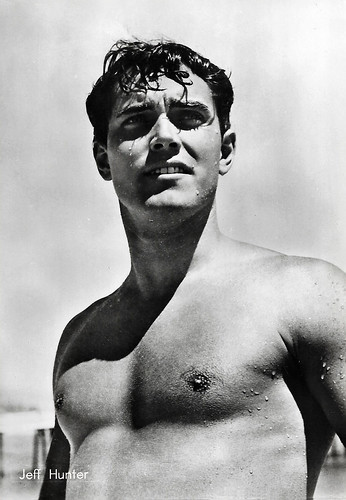
Italian postcard by Bromostampa, Milano, no. 264.
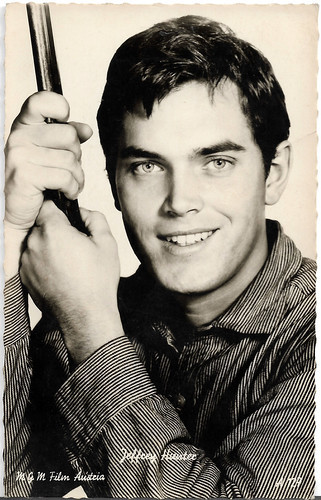
Austrian postcard by HDH Verlag, no. A 127. Photo: MGM.
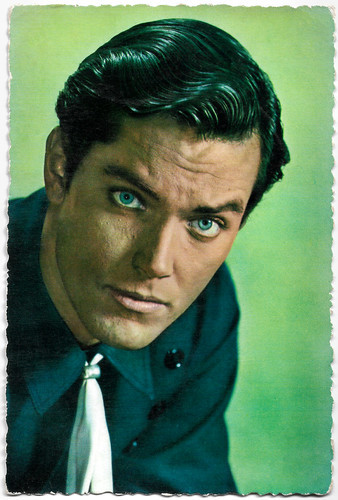
Spanish postcard by Raker, no. 1020.
Tall, blue-eyed, and impossibly good-looking
Jeffrey Hunter was born Henry Herman McKinnies Jr. in 1926 in New Orleans, Louisiana, the only child of Edith Lois (née Burgess) and Henry Herman McKinnies. His parents met at the University of Arkansas, and when he was almost four his family moved to Milwaukee, Wisconsin.
In his teens, he acted in productions of the North Shore Children's Theater, and from 1942 to 1944 performed in summer stock with the local Port Players, along with Eileen Heckart, Charlotte Rae, and Morton DaCosta, and was a radio actor at WTMJ, getting his first professional paycheck in 1945 for the wartime series 'Those Who Serve'.
After graduation from Whitefish Bay High School, where he was co-captain of the football team, he enlisted in the United States Navy and underwent training at Great Lakes Naval Station, Illinois, in 1945-1946. However, on the eve of his transfer to duty in Japan, he took ill and received a medical discharge from the service.
Hunter attended and graduated from Northwestern University in Illinois with a bachelor's degree in 1949, where he acquired more stage experience in Richard Brinsley Sheridan's 'The Rivals' and Ruth Gordon's 'Years Ago'. He also did summer stock with Northwestern students at Eagles Mere, Pennsylvania in 1948, worked on two Northwestern Radio Playshop broadcasts, was president of Phi Delta Theta Fraternity, and was active in the campus film society with David Bradley. Later he acted in Bradley's production of Julius Caesar (David Bradley, 1950), the first film adaptation of the Shakespeare play with actors including young Charlton Heston and students from the Chicago area.
He went to graduate school at the University of California, Los Angeles, where he studied radio and drama. He was in the cast of a UCLA production of 'All My Sons' in May 1950, and on opening night talent scouts for Paramount and 20th Century Fox in the audience zeroed in on the tall, blue-eyed, and impossibly good-looking Hunter.
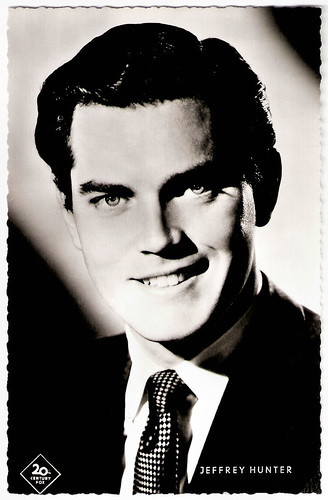
West-German postcard by Kunst und Bild, Berlin-Charlottenburg, no. T 834. Photo: 20th Century Fox.
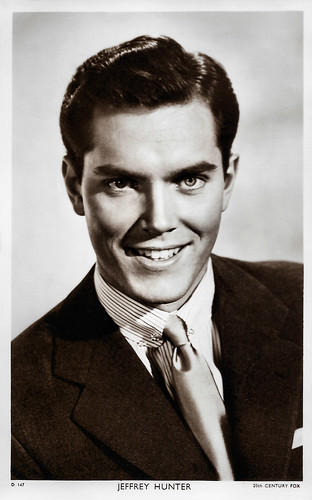
British postcard in the Picturegoer Series, no. D 147. Photo: 20th Century Fox.
Searching for a child kidnapped by Comanches
Jeffrey Hunter made a screen test with Ed Begley in a scene from All My Sons at Paramount where he met Barbara Rush, his future wife. An executive shake-up at that studio derailed his hiring, but in 1950, 20th Century-Fox head Darryl F. Zanuck signed him to a contract and changed his name from Henry Herman McKinnies Jr to Jeffrey Hunter.
He was almost immediately sent on location in New York for a small role in Fourteen Hours (Henry Hathaway, 1951) with Richard Basehart . Hunter was given a bigger part in the all-male war film The Frogmen (Lewis Milestone, 1951), supporting Richard Widmark and Dana Andrews . Among his fellow support players was Robert Wagner, another young male under contract to Fox at the time — the two actors would appear in several films together and were often rivals for the same part.
Fan response to these appearances was positive and Hunter moved into leading roles with the adventure drama Red Skies of Montana (Joseh M. Newman, 1952), billed third in this film about smokejumpers (specially trained wildland firefighters who provide an initial attack response on remote wildland fires) with Richard Widmark. He had a more conventional male juvenile lead in the family comedy film Belles on Their Toes (Henry Levin, 1953), a sequel to Cheaper by the Dozen, with Jeanne Crain. Hunter was kept fairly busy in pictures, working his way from featured roles to starring roles to first billing within two years in the British film Single-Handed (Roy Boulting, 1953).
Hunter then played an Indian chief in the Western, White Feather (Robert D. Webb, 1955), essentially supporting Robert Wagner. It was a moderate hit at the box office. His big break came with The Searchers (John Ford, 1956), where he played the young cowboy who accompanies John Wayne on his search for a child kidnapped by Comanches. Hunter got excellent reviews for his performance in this film and justifiably so, as he held his own well with the veteran Wayne. Starring roles in two more John Ford films followed, The Last Hurrah (John Ford, 1958), starring Spencer Tracy, and Sergeant Rutledge (John Ford, 1960).
Hunter was reunited with Robert Wagner as the James brothers in The True Story of Jesse James (Nicholas Ray, 1957) in which Hunter played Frank). The film was mildly popular although considered a critical disappointment. In 1960 Hunter had one of his best roles in Hell to Eternity (Phil Karlson, 1960), the true story of World War II hero Guy Gabaldon. That same year, Hunter landed the role for which he is probably best known when he played the Son of God in King of Kings (Nicholas Ray, 1961). It was a difficult part met by a critical reaction that ranged from praise to ridicule. Hunter's youthful matinee-idol looks resulted in the film being derided as 'I Was a Teenage Jesus', despite the actor's age at the time. However, it was a big hit at the box office and remains one of Hunter's best-remembered roles.
For his old Fox boss Darryl F. Zanuck he joined an all-star cast in the World War II epic The Longest Day (Ken Annakin, Andrew Marton, Bernhard Wicki, 1962). Hunter provided a climactic heroic moment playing a sergeant who is killed while leading a successful attempt to breach the defense wall atop Omaha Beach in Normandy. He headed to Italy to make Oro per i Cesari/Gold for the Caesars (André De Toth, Sabatino Ciuffini, 1963) with Mylène Demongeot . Originally planned as an American production, the film later became an Italian-French co-production after the poor box office return of King of Kings. It was shot in Italy in 1962.
Having guest-starred on television dramas since the mid-1950s, Hunter was then offered a two-year contract by Warner Bros. studio boss Jack Warner that included starring as circuit-riding Texas lawyer Temple Lea Houston, the youngest son of Sam Houston, in the NBC series Temple Houston (1963–1964), which Hunter's production company co-produced. Jack Elam was his co-star, as gunslinger-turned-marshal George Taggart. After the cancellation of Temple Houston, his career took a downturn. He was cast as Christopher Pike, captain of the USS Enterprise, in the original Star Trek pilot in 1964. However, when an undecided NBC requested a second pilot in early 1965, Hunter declined, having decided to concentrate on his film career, instead.
With the demise of the studio contract system in the early 1960s and the outsourcing of much feature production, Hunter, like many other leading men of the 1950s, found work in B movies produced in Italy, Hong Kong, and Mexico, with the occasional television guest part in Hollywood. He returned to Italy where he starred in the Spaghetti Western Joe... cercati un posto per morire!/Find a Place to Die! (Giuliano Carnimeo, 1968) with Pascale Petit .
In 1969, Jeffrey Hunter suffered a stroke (after just recovering from an earlier stroke), took a bad fall, and underwent emergency surgery, but died from complications of both the fall and the surgery. He was interred at Glen Haven Memorial Park in Sylmar, California. Hunter was married to Barbara Rush (1950-1955), Joan Bartlett (1957-1967), and Emily McLaughlin (1969-1969). He had a son with Rush, Christopher Hunter, and two sons with Bartlett, Todd Hunter, and Scott Hunter.
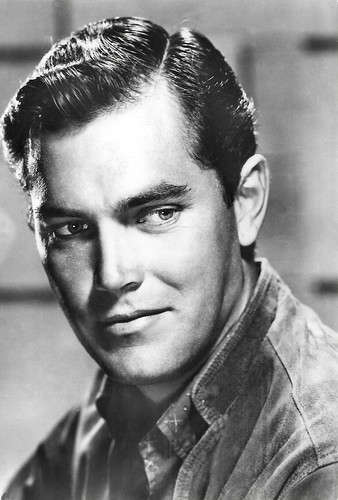
Spanish postcard by Ediciones Raker, Barcelona, no. 129. Photo: Warner Bros. Publicity still for Sergeant Rutledge (John Ford, 1960).
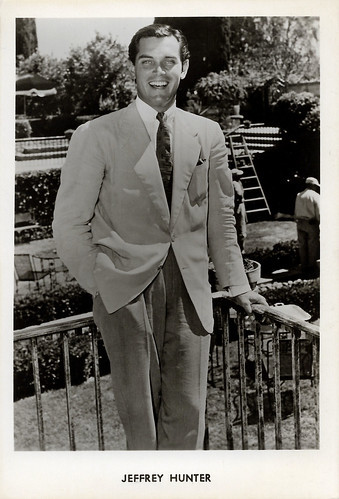
Belgian postcard, no. 5359.
Sources: (IMDb), Wikipedia, and .

Italian postcard by Bromostampa, Milano, no. 264.

Austrian postcard by HDH Verlag, no. A 127. Photo: MGM.

Spanish postcard by Raker, no. 1020.
Tall, blue-eyed, and impossibly good-looking
Jeffrey Hunter was born Henry Herman McKinnies Jr. in 1926 in New Orleans, Louisiana, the only child of Edith Lois (née Burgess) and Henry Herman McKinnies. His parents met at the University of Arkansas, and when he was almost four his family moved to Milwaukee, Wisconsin.
In his teens, he acted in productions of the North Shore Children's Theater, and from 1942 to 1944 performed in summer stock with the local Port Players, along with Eileen Heckart, Charlotte Rae, and Morton DaCosta, and was a radio actor at WTMJ, getting his first professional paycheck in 1945 for the wartime series 'Those Who Serve'.
After graduation from Whitefish Bay High School, where he was co-captain of the football team, he enlisted in the United States Navy and underwent training at Great Lakes Naval Station, Illinois, in 1945-1946. However, on the eve of his transfer to duty in Japan, he took ill and received a medical discharge from the service.
Hunter attended and graduated from Northwestern University in Illinois with a bachelor's degree in 1949, where he acquired more stage experience in Richard Brinsley Sheridan's 'The Rivals' and Ruth Gordon's 'Years Ago'. He also did summer stock with Northwestern students at Eagles Mere, Pennsylvania in 1948, worked on two Northwestern Radio Playshop broadcasts, was president of Phi Delta Theta Fraternity, and was active in the campus film society with David Bradley. Later he acted in Bradley's production of Julius Caesar (David Bradley, 1950), the first film adaptation of the Shakespeare play with actors including young Charlton Heston and students from the Chicago area.
He went to graduate school at the University of California, Los Angeles, where he studied radio and drama. He was in the cast of a UCLA production of 'All My Sons' in May 1950, and on opening night talent scouts for Paramount and 20th Century Fox in the audience zeroed in on the tall, blue-eyed, and impossibly good-looking Hunter.

West-German postcard by Kunst und Bild, Berlin-Charlottenburg, no. T 834. Photo: 20th Century Fox.

British postcard in the Picturegoer Series, no. D 147. Photo: 20th Century Fox.
Searching for a child kidnapped by Comanches
Jeffrey Hunter made a screen test with Ed Begley in a scene from All My Sons at Paramount where he met Barbara Rush, his future wife. An executive shake-up at that studio derailed his hiring, but in 1950, 20th Century-Fox head Darryl F. Zanuck signed him to a contract and changed his name from Henry Herman McKinnies Jr to Jeffrey Hunter.
He was almost immediately sent on location in New York for a small role in Fourteen Hours (Henry Hathaway, 1951) with Richard Basehart . Hunter was given a bigger part in the all-male war film The Frogmen (Lewis Milestone, 1951), supporting Richard Widmark and Dana Andrews . Among his fellow support players was Robert Wagner, another young male under contract to Fox at the time — the two actors would appear in several films together and were often rivals for the same part.
Fan response to these appearances was positive and Hunter moved into leading roles with the adventure drama Red Skies of Montana (Joseh M. Newman, 1952), billed third in this film about smokejumpers (specially trained wildland firefighters who provide an initial attack response on remote wildland fires) with Richard Widmark. He had a more conventional male juvenile lead in the family comedy film Belles on Their Toes (Henry Levin, 1953), a sequel to Cheaper by the Dozen, with Jeanne Crain. Hunter was kept fairly busy in pictures, working his way from featured roles to starring roles to first billing within two years in the British film Single-Handed (Roy Boulting, 1953).
Hunter then played an Indian chief in the Western, White Feather (Robert D. Webb, 1955), essentially supporting Robert Wagner. It was a moderate hit at the box office. His big break came with The Searchers (John Ford, 1956), where he played the young cowboy who accompanies John Wayne on his search for a child kidnapped by Comanches. Hunter got excellent reviews for his performance in this film and justifiably so, as he held his own well with the veteran Wayne. Starring roles in two more John Ford films followed, The Last Hurrah (John Ford, 1958), starring Spencer Tracy, and Sergeant Rutledge (John Ford, 1960).
Hunter was reunited with Robert Wagner as the James brothers in The True Story of Jesse James (Nicholas Ray, 1957) in which Hunter played Frank). The film was mildly popular although considered a critical disappointment. In 1960 Hunter had one of his best roles in Hell to Eternity (Phil Karlson, 1960), the true story of World War II hero Guy Gabaldon. That same year, Hunter landed the role for which he is probably best known when he played the Son of God in King of Kings (Nicholas Ray, 1961). It was a difficult part met by a critical reaction that ranged from praise to ridicule. Hunter's youthful matinee-idol looks resulted in the film being derided as 'I Was a Teenage Jesus', despite the actor's age at the time. However, it was a big hit at the box office and remains one of Hunter's best-remembered roles.
For his old Fox boss Darryl F. Zanuck he joined an all-star cast in the World War II epic The Longest Day (Ken Annakin, Andrew Marton, Bernhard Wicki, 1962). Hunter provided a climactic heroic moment playing a sergeant who is killed while leading a successful attempt to breach the defense wall atop Omaha Beach in Normandy. He headed to Italy to make Oro per i Cesari/Gold for the Caesars (André De Toth, Sabatino Ciuffini, 1963) with Mylène Demongeot . Originally planned as an American production, the film later became an Italian-French co-production after the poor box office return of King of Kings. It was shot in Italy in 1962.
Having guest-starred on television dramas since the mid-1950s, Hunter was then offered a two-year contract by Warner Bros. studio boss Jack Warner that included starring as circuit-riding Texas lawyer Temple Lea Houston, the youngest son of Sam Houston, in the NBC series Temple Houston (1963–1964), which Hunter's production company co-produced. Jack Elam was his co-star, as gunslinger-turned-marshal George Taggart. After the cancellation of Temple Houston, his career took a downturn. He was cast as Christopher Pike, captain of the USS Enterprise, in the original Star Trek pilot in 1964. However, when an undecided NBC requested a second pilot in early 1965, Hunter declined, having decided to concentrate on his film career, instead.
With the demise of the studio contract system in the early 1960s and the outsourcing of much feature production, Hunter, like many other leading men of the 1950s, found work in B movies produced in Italy, Hong Kong, and Mexico, with the occasional television guest part in Hollywood. He returned to Italy where he starred in the Spaghetti Western Joe... cercati un posto per morire!/Find a Place to Die! (Giuliano Carnimeo, 1968) with Pascale Petit .
In 1969, Jeffrey Hunter suffered a stroke (after just recovering from an earlier stroke), took a bad fall, and underwent emergency surgery, but died from complications of both the fall and the surgery. He was interred at Glen Haven Memorial Park in Sylmar, California. Hunter was married to Barbara Rush (1950-1955), Joan Bartlett (1957-1967), and Emily McLaughlin (1969-1969). He had a son with Rush, Christopher Hunter, and two sons with Bartlett, Todd Hunter, and Scott Hunter.

Spanish postcard by Ediciones Raker, Barcelona, no. 129. Photo: Warner Bros. Publicity still for Sergeant Rutledge (John Ford, 1960).

Belgian postcard, no. 5359.
Sources: (IMDb), Wikipedia, and .
Published on September 16, 2021 22:00
September 15, 2021
Joan Barry
Joan Barry (1903-1989) was an English stage and film actress, whose career straddled the development of talkies.
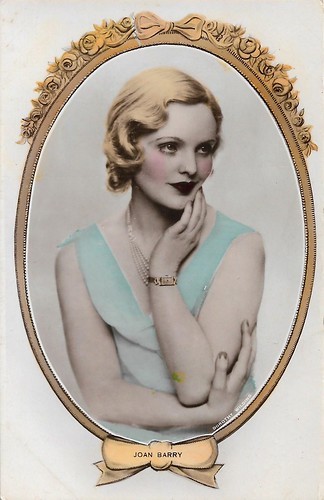
British postcard in the Cameo Series, London, no. KC05. Photo: Dorothy Wilding.
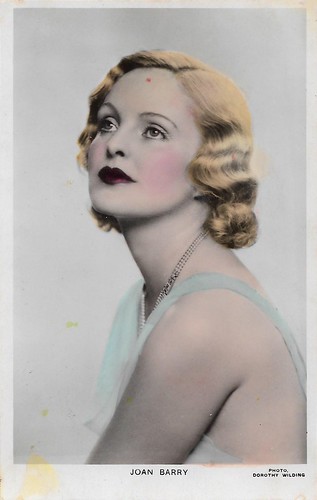
British postcard in the Colourgraph series, no. C.170. Photo: Dorothy Wilding.
A blackmail family drama
Joan Barry was born Ina Florence Marshman Bell in Carlisle, in 1903. She was the daughter of Francis Marshman Bell and wife Norah Cavanagh.
She had her first role at the age of 15, a small part in 'Luck of the Navy'. Barry appeared at St James's Theatre, London when seventeen.
From 1922 Joan Barry acted in silent cinema. She first acted in the comedy The Card (A.V. Bramble, 1922). It is an adaptation of the 1911 novel 'The Card' by Arnold Bennett.
She already had the female lead in her next film, Hutch Stirs 'em Up (Frank Hall Crane, 1923), starring Charles Hutchison as cowboy hero Hurricane Hutch and Joan as a damsel in distress.
After the blackmail family drama The Happy Ending (George A. Cooper, 1925), Barry's last silent film performance was in The Rising Generation (George Dewhurst, Harley Knoles, 1928) with Alice Joyce.
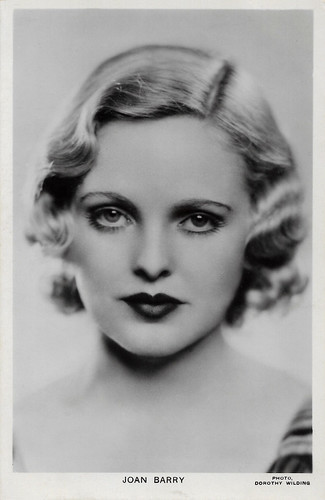
British postcard in the Picturegoer Series, London, no. 557a. Photo: Dorothy Wilding.
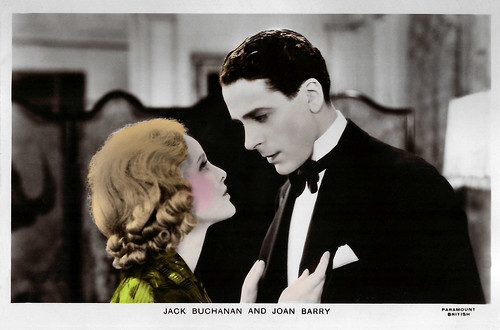
British postcard in the Film Partners Series, London, no. PC 115. Photo: Paramount British. Jack Buchanan and Joan Barry in A Man of Mayfair (Louis Mercanton, 1931).
Dubbing the voice of Anny Ondra
Joan Barry memorably dubbed the voice of Anny Ondra in the early Alfred Hitchcock thriller Blackmail (1929), which halfway production was turned into a sound film. The film is about a London woman who is blackmailed after killing a man who tries to rape her.
The limited sound technology available at the time meant that Barry had to dub the Czech actress in real-time as she performed the role. Ondra mimicked the lines while Barry talked into a microphone "and somehow they managed to synchronize", as Ronald Neame remarked in Kevin Brownlow and David Gill's series Cinema Europe. The film was a critical and commercial hit.
Two years later, Barry appeared on-screen for Hitchcock in Rich and Strange (Alfred Hitchcock, 1931) with Henry Kendall. The next years, she continued to appear in a mixture of leading and top supporting roles, most memorably in the thriller Rome Express (Walter Forde, 1932), starring Esther Ralston and Conrad Veidt .
She retired from the screen after her first marriage to Henry Hampson in 1934. On 3 October 1936, she married her second husband, Henry Frederick Tiarks III (1900-1995), a wealthy merchant banker also marrying for the second time.
They had two children. One of them, Edward Henry Tiarks, died when he was only six months old in 1943. The other, Henrietta Joan Tiarks, married Robin Russell, the Marquess of Tavistock, who eventually became the 14th Duke of Bedford. She is now Henrietta, Dowager Duchess of Bedford. Joan Barry was the Godmother of James Macintyre Boyd.
In 1989, Joan Barry passed away in Marbella, Spain, at the age of 85.
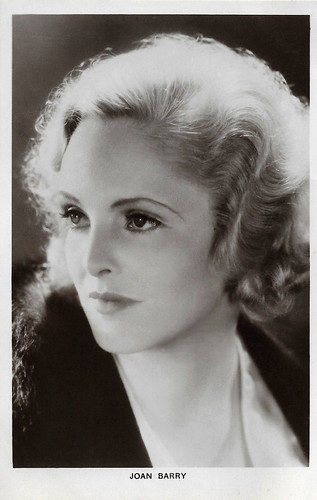
British postcard in the Picturegoer Series, London, no. 557.
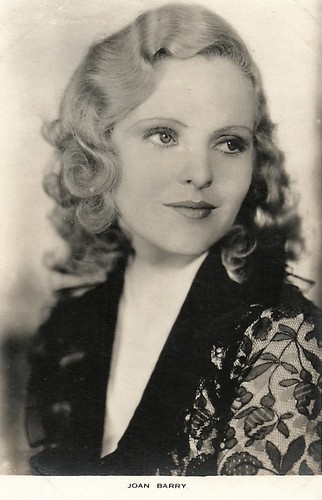
British postcard by Film Weekly, London, no. 112.
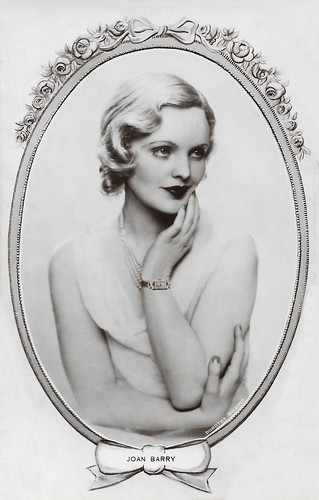
British postcard in the Cameo Series, London, no. K 5. Photo: Dorothy Wilding.
Sources: Wikipedia and .

British postcard in the Cameo Series, London, no. KC05. Photo: Dorothy Wilding.

British postcard in the Colourgraph series, no. C.170. Photo: Dorothy Wilding.
A blackmail family drama
Joan Barry was born Ina Florence Marshman Bell in Carlisle, in 1903. She was the daughter of Francis Marshman Bell and wife Norah Cavanagh.
She had her first role at the age of 15, a small part in 'Luck of the Navy'. Barry appeared at St James's Theatre, London when seventeen.
From 1922 Joan Barry acted in silent cinema. She first acted in the comedy The Card (A.V. Bramble, 1922). It is an adaptation of the 1911 novel 'The Card' by Arnold Bennett.
She already had the female lead in her next film, Hutch Stirs 'em Up (Frank Hall Crane, 1923), starring Charles Hutchison as cowboy hero Hurricane Hutch and Joan as a damsel in distress.
After the blackmail family drama The Happy Ending (George A. Cooper, 1925), Barry's last silent film performance was in The Rising Generation (George Dewhurst, Harley Knoles, 1928) with Alice Joyce.

British postcard in the Picturegoer Series, London, no. 557a. Photo: Dorothy Wilding.

British postcard in the Film Partners Series, London, no. PC 115. Photo: Paramount British. Jack Buchanan and Joan Barry in A Man of Mayfair (Louis Mercanton, 1931).
Dubbing the voice of Anny Ondra
Joan Barry memorably dubbed the voice of Anny Ondra in the early Alfred Hitchcock thriller Blackmail (1929), which halfway production was turned into a sound film. The film is about a London woman who is blackmailed after killing a man who tries to rape her.
The limited sound technology available at the time meant that Barry had to dub the Czech actress in real-time as she performed the role. Ondra mimicked the lines while Barry talked into a microphone "and somehow they managed to synchronize", as Ronald Neame remarked in Kevin Brownlow and David Gill's series Cinema Europe. The film was a critical and commercial hit.
Two years later, Barry appeared on-screen for Hitchcock in Rich and Strange (Alfred Hitchcock, 1931) with Henry Kendall. The next years, she continued to appear in a mixture of leading and top supporting roles, most memorably in the thriller Rome Express (Walter Forde, 1932), starring Esther Ralston and Conrad Veidt .
She retired from the screen after her first marriage to Henry Hampson in 1934. On 3 October 1936, she married her second husband, Henry Frederick Tiarks III (1900-1995), a wealthy merchant banker also marrying for the second time.
They had two children. One of them, Edward Henry Tiarks, died when he was only six months old in 1943. The other, Henrietta Joan Tiarks, married Robin Russell, the Marquess of Tavistock, who eventually became the 14th Duke of Bedford. She is now Henrietta, Dowager Duchess of Bedford. Joan Barry was the Godmother of James Macintyre Boyd.
In 1989, Joan Barry passed away in Marbella, Spain, at the age of 85.

British postcard in the Picturegoer Series, London, no. 557.

British postcard by Film Weekly, London, no. 112.

British postcard in the Cameo Series, London, no. K 5. Photo: Dorothy Wilding.
Sources: Wikipedia and .
Published on September 15, 2021 22:00
September 14, 2021
Lena Amsel
Lena Amsel (1898-1929) was a dancer and actress. Between 1917 and 1923, she appeared in several silent German films. She died in a car accident during an impromptu race.
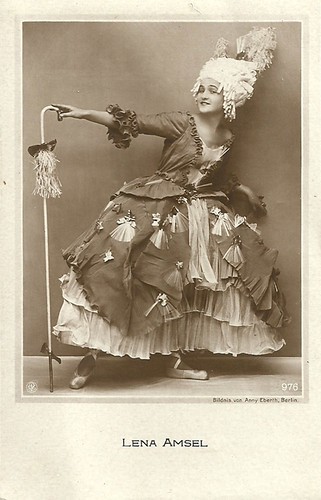
German postcard by NPG, no. 976. Photo: Anny Eberth.
Contact with the greats of vaudeville, film, and theatre
Lena Amsel was born in Lodz, Poland, Russian Empire, in 1898. She came from Jewish manufacturing circles.
In 1914 Amsel moved to Dresden, and in 1915 to Berlin. She sought contact with the greats of vaudeville, film, and theatre. In 1916, she met Karl Gustav Vollmoeller and Max Reinhardt in the Café des Westens. Vollmoeller became her lover and patron for several years.
In 1917 she appeared on stage as a dancer in the Berlin Varieté Theater Wintergarten, shortly afterward in front of the camera in Vienna. In 1917/1918 she appeared in the Austrian silent films Pinselputzi stiftet Unheil und eine Ehe, Pinselputzi rendevouzelt, Lenas noble Bekanntschaft, Meine Tochter, deine Tochter and Der Weg zum Reichtum, produced partly by PAGU and partly by by Sascha.
Although she had no dance training, Lena Amsel was able to hold her own as a dancer on German and Austrian stages for several years. Her film career also continued in the early 1920s.
In 1922/1923 she had a small part in the four-episode film Tragödie der Liebe/Tragedy of Love, directed by Joe May , starring Mia May and with co-actors Vladimir Gajdarov , Emil Jannings , and Erika Glässner .
Her last film was Der allmächtige Dollar/The Mighty Dollar (Jaap Speyer, 1923), alongside Eduard von Winterstein . NB IMDb mentions also Die Gräfin von Paris but this is the same film as Tragödie der Liebe.
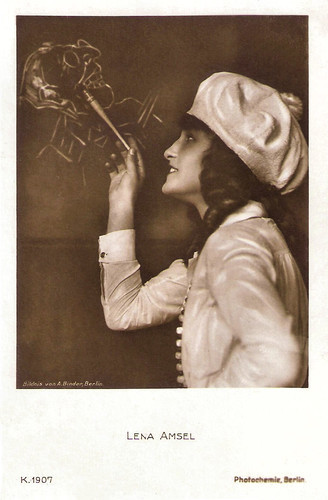
German postcard by Photochemie, Berlin, no. K. 1907. Photo: Alex Binder, Berlin.
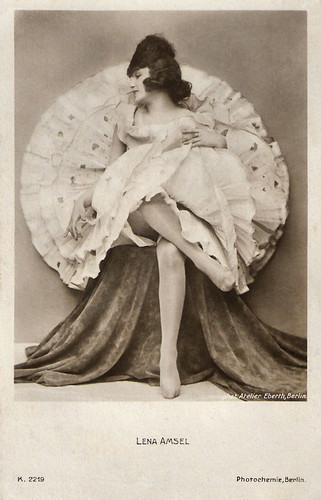
German postcard by Photochemie, Berlin, no. K. 2219. Photo: Atelier Eberth (Anny Eberth).
An impromptu race with Bugatti sports cars
In private life. Lena Amsel's liaison with Vollmöller from 1917 to 1924 was interrupted by three short marriages and three divorces. In 1927 Lena Amsel moved to Paris.
Through Vollmoeller she came into contact with renowned French artists: André Derain, Georges Braque, Pablo Picasso, Ossip Zadkine, Louis Aragon, André Breton, René Crevel, and Paul Éluard.
Lena Amsel died near Paris on 2 November 1929 at the age of 31 as a result of an automobile accident that occurred on a road between Paris and Fontainebleau. There, the dancer and the painter André Derain, who drove a Bugatti sports car as she did, had challenged each other to an impromptu race. Amsel's car skidded, overturned, and caught fire.
Derain was unable to rescue her and her friend Florence Pitron, who also died in the fatal accident, from the burning wreckage. Lena Amsel was buried in Paris at the Cimetière du Montparnasse.
Lena Amsel's life and fate inspired Ruth Landshoff to write her fictional biography, probably completed in 1933, entitled 'Roman einer Tänzerin' (Novel of a Dancer). The work was banned from publication due to the Nazi seizure of power in Germany. The posthumous first edition was printed almost 70 years later in 2002.
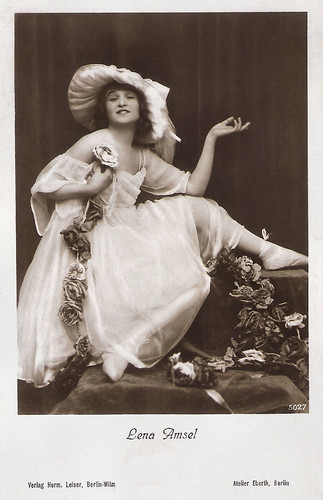
German postcard by Verlag Herm. Leiser, Berlin-Wilm., no. 5027. Photo: Atelier Eberth, Berlin.
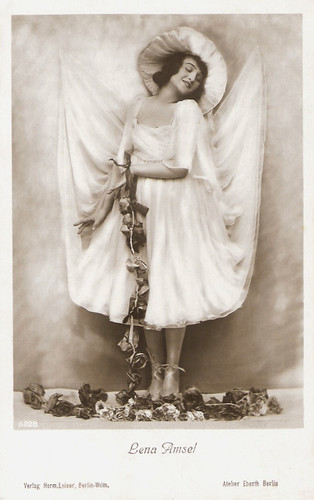
German postcard by Verlag Herm. Leiser, Berlin-Wilm., no. 5028. Photo: Atelier Eberth (Anny Eberth).
Source: Wikipedia (German and English), Filmportal, and .

German postcard by NPG, no. 976. Photo: Anny Eberth.
Contact with the greats of vaudeville, film, and theatre
Lena Amsel was born in Lodz, Poland, Russian Empire, in 1898. She came from Jewish manufacturing circles.
In 1914 Amsel moved to Dresden, and in 1915 to Berlin. She sought contact with the greats of vaudeville, film, and theatre. In 1916, she met Karl Gustav Vollmoeller and Max Reinhardt in the Café des Westens. Vollmoeller became her lover and patron for several years.
In 1917 she appeared on stage as a dancer in the Berlin Varieté Theater Wintergarten, shortly afterward in front of the camera in Vienna. In 1917/1918 she appeared in the Austrian silent films Pinselputzi stiftet Unheil und eine Ehe, Pinselputzi rendevouzelt, Lenas noble Bekanntschaft, Meine Tochter, deine Tochter and Der Weg zum Reichtum, produced partly by PAGU and partly by by Sascha.
Although she had no dance training, Lena Amsel was able to hold her own as a dancer on German and Austrian stages for several years. Her film career also continued in the early 1920s.
In 1922/1923 she had a small part in the four-episode film Tragödie der Liebe/Tragedy of Love, directed by Joe May , starring Mia May and with co-actors Vladimir Gajdarov , Emil Jannings , and Erika Glässner .
Her last film was Der allmächtige Dollar/The Mighty Dollar (Jaap Speyer, 1923), alongside Eduard von Winterstein . NB IMDb mentions also Die Gräfin von Paris but this is the same film as Tragödie der Liebe.

German postcard by Photochemie, Berlin, no. K. 1907. Photo: Alex Binder, Berlin.

German postcard by Photochemie, Berlin, no. K. 2219. Photo: Atelier Eberth (Anny Eberth).
An impromptu race with Bugatti sports cars
In private life. Lena Amsel's liaison with Vollmöller from 1917 to 1924 was interrupted by three short marriages and three divorces. In 1927 Lena Amsel moved to Paris.
Through Vollmoeller she came into contact with renowned French artists: André Derain, Georges Braque, Pablo Picasso, Ossip Zadkine, Louis Aragon, André Breton, René Crevel, and Paul Éluard.
Lena Amsel died near Paris on 2 November 1929 at the age of 31 as a result of an automobile accident that occurred on a road between Paris and Fontainebleau. There, the dancer and the painter André Derain, who drove a Bugatti sports car as she did, had challenged each other to an impromptu race. Amsel's car skidded, overturned, and caught fire.
Derain was unable to rescue her and her friend Florence Pitron, who also died in the fatal accident, from the burning wreckage. Lena Amsel was buried in Paris at the Cimetière du Montparnasse.
Lena Amsel's life and fate inspired Ruth Landshoff to write her fictional biography, probably completed in 1933, entitled 'Roman einer Tänzerin' (Novel of a Dancer). The work was banned from publication due to the Nazi seizure of power in Germany. The posthumous first edition was printed almost 70 years later in 2002.

German postcard by Verlag Herm. Leiser, Berlin-Wilm., no. 5027. Photo: Atelier Eberth, Berlin.

German postcard by Verlag Herm. Leiser, Berlin-Wilm., no. 5028. Photo: Atelier Eberth (Anny Eberth).
Source: Wikipedia (German and English), Filmportal, and .
Published on September 14, 2021 22:00
September 13, 2021
Dobry vojak Svejk (1955)
Because of his brilliant puppet animations, Czech puppeteer and stop-motion film-maker Jiří Trnka (1912-1969) was called ‘the Walt Disney of Eastern Europe’. For Dobry vojak Svejk/The Good Soldier Svejk (1955), he adapted the classic anti-war satire 'Švejk' by Jaroslav Hašek. Adapting this raucous satirical novel, and also bringing Josef Lada's equally famous illustrations to garrulous puppet life, posed Trnka one of his biggest creative challenges.
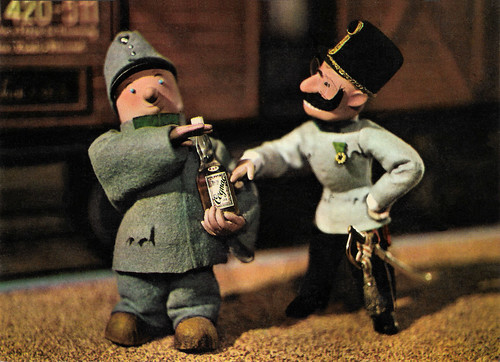
Czechoslovakian postcard by Tisk Severogravia Decin, no. 10-521-O-1. Photo: still from Dobry vojak Svejk/The Good Soldier Svejk (Jirî Trnka, 1955).
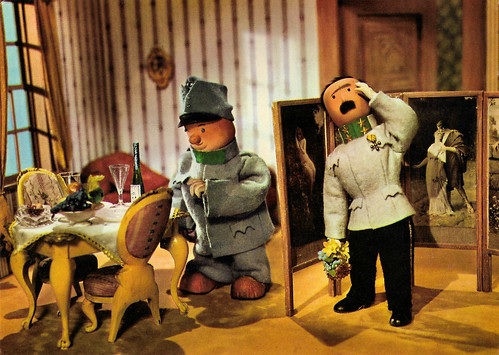
Czechoslovakian postcard by Tisk Severogravia Decin, no. 10-521-O-2. Photo: still from Dobry vojak Svejk/The Good Soldier Svejk (Jirî Trnka, 1955).
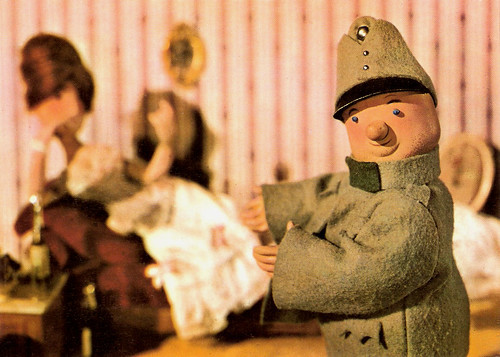
Czechoslovakian postcard by Tisk Severogravia Decin, no. 10-521-O-3. Photo: still from Dobry vojak Svejk/The Good Soldier Svejk (Jirî Trnka, 1955).
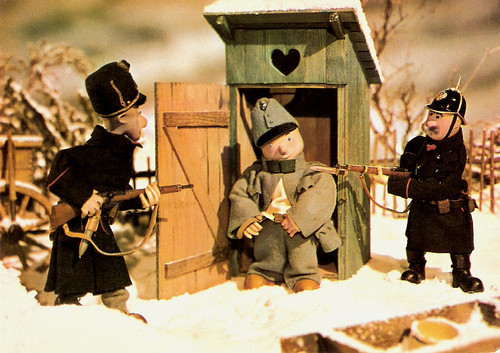
Czechoslovakian postcard by Tisk Severogravia Decin, no. 10-521-O-4. Photo: still from Dobry vojak Svejk/The Good Soldier Svejk (Jirî Trnka, 1955).
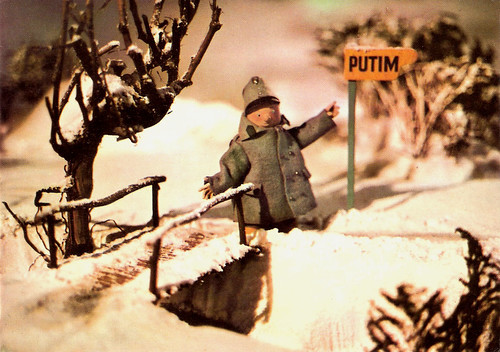
Czechoslovakian postcard by Tisk Severogravia Decin, no. 10-521-O-5. Photo: still from Dobry vojak Svejk/The Good Soldier Svejk (Jirî Trnka, 1955).
Brothers in tricks
Jiří Trnka was born in the city of Pilsen, in western Bohemia, Austria-Hungary (now Plzeň, Czech Republic) in 1912. Although his father was a plumber and his mother a dressmaker, both remained very close to their peasant origins. From the moment he could hold a pencil, Jiří drew pictures. Young Jiří also enjoyed sculpting puppets made of wood and put on small shows for friends. At secondary school, his drawing teacher was Josef Skupa, who eventually would become a leading public figure in the world of Czech puppeteers.
Skupa became his mentor, entrusted Trnka with certain responsibilities, and managed to convince his family, who were initially reluctant, to allow him to enroll at the prestigious School of Applied Arts in Prague, where he completed his apprenticeship between 1929 and 1935. Trnka soon began a successful career as an illustrator. He was hired by the Prague publishing house Melantrich, and his first illustrated work was 'Tygr pana Boška' (The Tiger of Mr. Bošek) by Vítězslav Šmejc, published in 1937.
Since then, Trnka illustrated numerous children's books. Throughout his life, he illustrated 130 works of literature, most of them for children. Especially famous are his illustrations for the tales of the Brothers Grimm, as well as collections of folktales from Czech authors such as Jiří Horák and Jan Páleníček. Also related to his native folklore are his illustrations for 'Bajaja' by Vladimír Holan, published in 1955, which would also be the starting point for his future in animation. In addition to the above, Trnka illustrated the tales of Hans Christian Andersen and Charles Perrault, the fables of Jean de La Fontaine, 'The Thousand and One Nights', several works of William Shakespeare, and Lewis Carroll's 'Alice in Wonderland'.
In 1936 Trnka also began a wooden puppet theatre on Prague’s Wenceslas Square, which was disbanded after the outbreak of World War II. During the war, he designed stage sets and illustrated Špalíček veršů a pohádek, a collection of Czech rhymes and fairy tales by František Hrubín.In the immediate wake of World War II, Trnka founded Bratři v triku (Brothers in tricks) with fellow animators Eduard Hofman and Jiří Brdečka. This studio, dedicated to the production of traditional, hand-drawn animation, lives on today.
Their first film was Zasadil dědek řepu/Grandpa Planted a Beet (1945). Then, Trnka had three hand-drawn shorts screened at the first Cannes Film Festival in 1946. While Dárek/The Gift was received as a truly radical work, it was Zvířátka a petrovští/The Animals and the Robbers (1946) which won Trnka the Grand Prix. Cerise Howard at Senses of Cinema : 'Despite the bouquets for Trnka’s cartoons, he was eager to move on to animating puppets. He was dissatisfied with the industrial nature of drawn animation, feeling that 'too many middle-men (artists, colour technicians) weakened the originality of the author’s drawings'. Furthermore, he was keen to create and shoot in three dimensions." He presented the ten-minute-long puppet film Christmassy Betlém/Bethlehem, which captures the atmosphere of a Czech folk Christmas and was a remarkably accomplished debut.
Trnka's first feature-length puppet film with the help of Břetislav Pojar, Špalíček/The Czech Year (Jiří Trnka, 1947), which told six separate folk tales of Czech life, based on a book illustrated by Mikoláš Aleš. It was a defining moment for Trnka as he won a Lion at the Venice Film Festival and several other international awards, three years running across Europe. Trnka’s growing prestige was something the Communist Party wanted a piece of upon their assumption of control of Czechoslovakia in early 1948. Henceforth, all of Trnka’s subsequent output was subsidised by the state, a situation which, just as for many compatriots in animation and in live-action, was liberating even as it was stifling.
The next film they produced was Cisaruv Slavik/The Emperor's Nightingale (1949), based on the 1843 fairy tale 'The Nightingale' by Hans Christian Andersen. Unlike the previous, it is a real feature film with one single storyline. Puppet animation is a traditional Czech art form, of which Trnka became the undisputed master. Most of his films were intended for adults and many were adaptations of literary works. These included feature-length covering working-class traditions and national heroes, such as Bajaja/Prince Bayaya (Jiří Trnka, 1950), and Staré povesti ceské/Old Czech Legends (Jiří Trnka, 1953). They made him an internationally recognised artist and the winner of film festival awards. He was a puppet-maker, a sculptor, and a set and stage designer. All of these talents were abundantly well utilised in his highly distinctive film work.
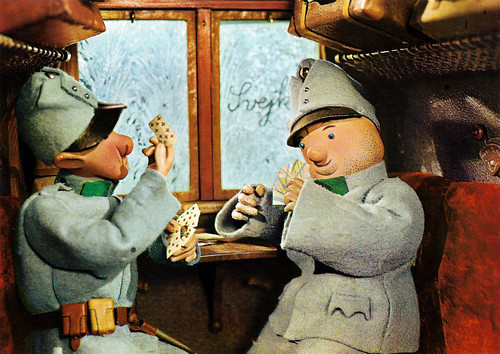
Czechoslovakian postcard by Tisk Severogravia Decin, no. 10-521-O-7. Photo: still from Dobry vojak Svejk/The Good Soldier Svejk (Jirî Trnka, 1955).
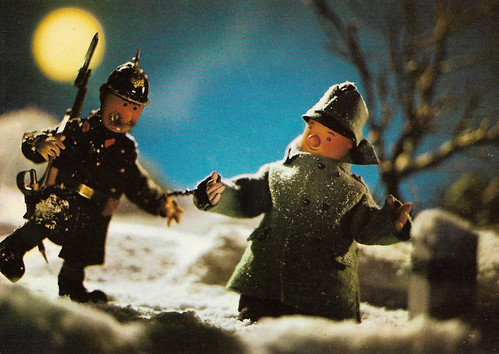
Czechoslovakian postcard by Tisk Severogravia Decin, no. 10-521-O-8. Photo: still from Dobry vojak Svejk/The Good Soldier Svejk (Jirî Trnka, 1955).
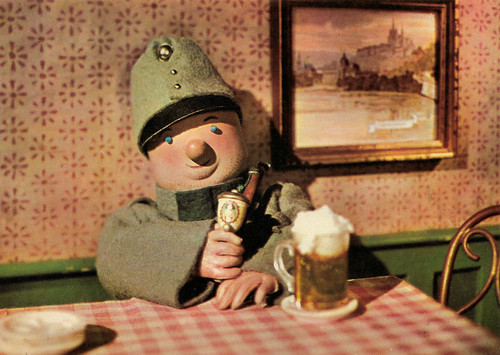
Czechoslovakian postcard by Tisk Severogravia Decin, no. 10-521-O-9. Photo: still from Dobry vojak Svejk/The Good Soldier Svejk (Jirî Trnka, 1955).
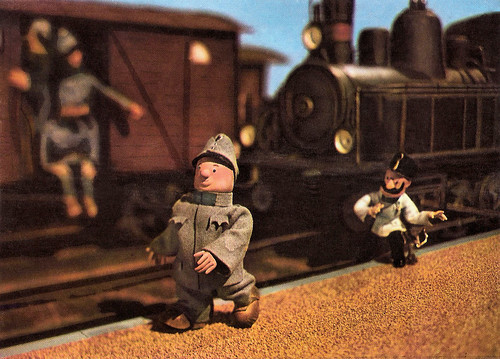
Czechoslovakian postcard by Tisk Severogravia Decin, no. 10-521-O-10. Photo: still from Dobry vojak Svejk/The Good Soldier Svejk (Jirî Trnka, 1955).
Anti-war satire
To explore the classics of Czech literature, Jiří Trnka decided in 1955 to adapt to the screen the immensely popular novel Osudy dobreho vojaka Svejka za svetove valky (The Good Soldier Švejk) written by Jaroslav Hašek. This anti-war satire is the most translated novel of Czech literature.
At the time, there already existed film adaptations with real actors, such as Dobrý voják Švejk/The Last Bohemian (Martin Frič, 1931), starring Saša Rašilov as Švejk. Trnka however was the first to make an animated film about the bumbling soldier who earnestly attempts to follow orders. For the construction of the puppets, Trnka was inspired by the illustrations for the original book made by Josef Lada, which in the popular imagination were closely associated with the characters of Hašek.
Dobry vojak Svejk/The Good Soldier Svejk (Jirî Trnka, 1955) is divided into three episodes, which tell the grotesque adventures of Švejk during World War I. The first episode takes place in a small station between Hatvan and Halič. The soldier Svejk is suspected by his superior of having drunk cognac which is strictly forbidden. He invents a story about sleeping on his feet to get out of the situation. In the second episode, Svejk accompanies an officer to the front. On the train, he accidentally triggers an emergency stop, which gets him into some trouble. And in the third episode, Svejk cannot find his battalion. A Russian spy interrogates him and a policeman has to escort him to the city. But this one being dead drunk, it is finally Svejk who brings him back to the police station.
The narrator of Dobry vojak Svejk/The Good Soldier Svejk was Jan Werich, who also co-wrote the script for the film with Trnka. Trnka himself felt that the final episode was the most artistically successful, but there's much to enjoy in all three, not least the way that the lackadaisical layabout Svejk's own self-serving anecdotes are realized through cut-out animation. The humorous film received awards at international festivals in Karlovy Vary, Locarno, and Montevideo.
Trnka's masterpiece was Sen noci svatojánské/A Midsummer Night’s Dream (Jirî Trnka, 1959), adapted from one of the most famous works of William Shakespeare. Trnka had previously illustrated this book so he knew it well. It was presented in Cannes in 1959 and was a resounding international success. Trnka was called the icon of ‘Eastern country’ animators. Cerise Howard at Senses of Cinema : “a stunningly beautiful, highly faithful adaptation of Shakespeare’s play. Several years in the making, the puppet animation is more liquid, more balletic than ever.”
Afterward, the filmmaker stopped making feature-length films. Over the next decade, the filmmaker made only a few short films, which were progressively in a pessimistic tone, such as Kybernetická babička/The Cybernetic Grandma (Jirî Trnka, 1962), a satire on the increasing importance of technology in everyday life. Archanděl Gabriel a paní Husa/The Archangel Gabriel and Ms. Goose (Jirî Trnka, 1964), set in medieval Venice, adapts one of the stories of the Decameron by Boccaccio. Trnka's last film, Ruka/The Hand (Jirî Trnka, 1965), was an unexpected and surprising break in his work thus far. In short, it is about a sculptor visited by a huge hand, which seeks the completion of a sculpture of itself. By rejecting the imposition, the artist is constantly pursued by the hand, ending with induced suicide and the hand officiating at his funeral. Ruka is considered a protest against the conditions imposed by the Czechoslovak communist state to artistic creation, and even some have seen in it an anticipation of the so-called Prague Spring.
In 1968, he received the international Hans Christian Andersen Medal for illustrators, recognising his career contribution to children's literature. Jiri Trnka died of complications from a heart condition in 1969 in Prague, only 57 years old. His funeral, held in Pilsen, was a large public event. Although The Hand initially had no problems with censorship, Trnka's film was banned four months after his death. All copies were confiscated by the secret police, put in a safe, and the film was forbidden for screening for the next twenty years.
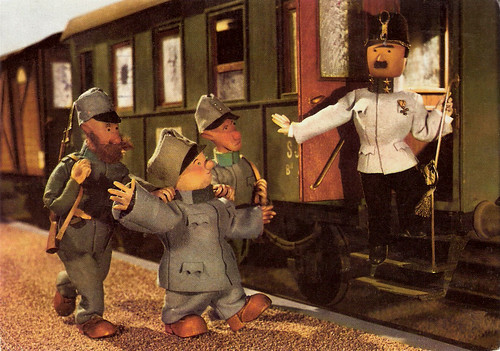
Czechoslovakian postcard by Tisk Severogravia Decin, no. 10-521-O-11. Photo: still from Dobry vojak Svejk/The Good Soldier Svejk (Jirî Trnka, 1955).
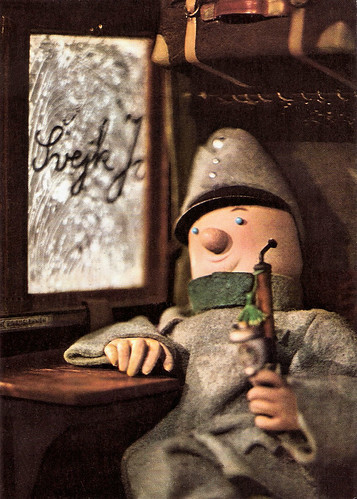
Czechoslovakian postcard by Tisk Severogravia Decin, no. 10-521-O-12. Photo: still from Dobry vojak Svejk/The Good Soldier Svejk (Jirî Trnka, 1955).
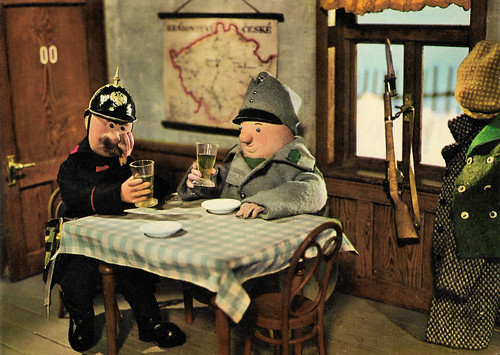
Czechoslovakian postcard by Tisk Severogravia Decin, no. 10-521-O-13. Photo: still from Dobry vojak Svejk/The Good Soldier Svejk (Jirî Trnka, 1955).
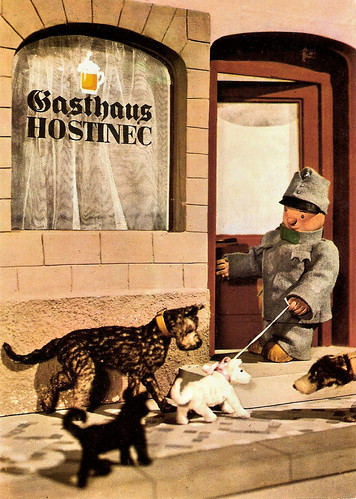
Czechoslovakian postcard by Tisk Severogravia Decin, no. 10-521-O-14. Photo: still from Dobry vojak Svejk/The Good Soldier Svejk (Jirî Trnka, 1955).
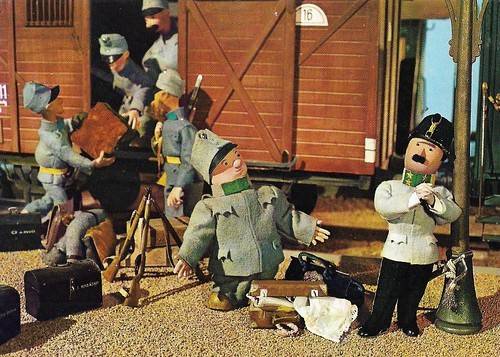
Czechoslovakian postcard by Tisk Severogravia Decin, no. 10-521-O-15. Photo: still from Dobry vojak Svejk/The Good Soldier Svejk (Jirî Trnka, 1955).
Sources: Cerise Howard (Senses of Cinema), Edgar Datko (Animation World Magazine), (IMDb), Thierry Méranger (Europe od Cultures), Dangerous Minds, Wikipedia (English and French), and .

Czechoslovakian postcard by Tisk Severogravia Decin, no. 10-521-O-1. Photo: still from Dobry vojak Svejk/The Good Soldier Svejk (Jirî Trnka, 1955).

Czechoslovakian postcard by Tisk Severogravia Decin, no. 10-521-O-2. Photo: still from Dobry vojak Svejk/The Good Soldier Svejk (Jirî Trnka, 1955).

Czechoslovakian postcard by Tisk Severogravia Decin, no. 10-521-O-3. Photo: still from Dobry vojak Svejk/The Good Soldier Svejk (Jirî Trnka, 1955).

Czechoslovakian postcard by Tisk Severogravia Decin, no. 10-521-O-4. Photo: still from Dobry vojak Svejk/The Good Soldier Svejk (Jirî Trnka, 1955).

Czechoslovakian postcard by Tisk Severogravia Decin, no. 10-521-O-5. Photo: still from Dobry vojak Svejk/The Good Soldier Svejk (Jirî Trnka, 1955).
Brothers in tricks
Jiří Trnka was born in the city of Pilsen, in western Bohemia, Austria-Hungary (now Plzeň, Czech Republic) in 1912. Although his father was a plumber and his mother a dressmaker, both remained very close to their peasant origins. From the moment he could hold a pencil, Jiří drew pictures. Young Jiří also enjoyed sculpting puppets made of wood and put on small shows for friends. At secondary school, his drawing teacher was Josef Skupa, who eventually would become a leading public figure in the world of Czech puppeteers.
Skupa became his mentor, entrusted Trnka with certain responsibilities, and managed to convince his family, who were initially reluctant, to allow him to enroll at the prestigious School of Applied Arts in Prague, where he completed his apprenticeship between 1929 and 1935. Trnka soon began a successful career as an illustrator. He was hired by the Prague publishing house Melantrich, and his first illustrated work was 'Tygr pana Boška' (The Tiger of Mr. Bošek) by Vítězslav Šmejc, published in 1937.
Since then, Trnka illustrated numerous children's books. Throughout his life, he illustrated 130 works of literature, most of them for children. Especially famous are his illustrations for the tales of the Brothers Grimm, as well as collections of folktales from Czech authors such as Jiří Horák and Jan Páleníček. Also related to his native folklore are his illustrations for 'Bajaja' by Vladimír Holan, published in 1955, which would also be the starting point for his future in animation. In addition to the above, Trnka illustrated the tales of Hans Christian Andersen and Charles Perrault, the fables of Jean de La Fontaine, 'The Thousand and One Nights', several works of William Shakespeare, and Lewis Carroll's 'Alice in Wonderland'.
In 1936 Trnka also began a wooden puppet theatre on Prague’s Wenceslas Square, which was disbanded after the outbreak of World War II. During the war, he designed stage sets and illustrated Špalíček veršů a pohádek, a collection of Czech rhymes and fairy tales by František Hrubín.In the immediate wake of World War II, Trnka founded Bratři v triku (Brothers in tricks) with fellow animators Eduard Hofman and Jiří Brdečka. This studio, dedicated to the production of traditional, hand-drawn animation, lives on today.
Their first film was Zasadil dědek řepu/Grandpa Planted a Beet (1945). Then, Trnka had three hand-drawn shorts screened at the first Cannes Film Festival in 1946. While Dárek/The Gift was received as a truly radical work, it was Zvířátka a petrovští/The Animals and the Robbers (1946) which won Trnka the Grand Prix. Cerise Howard at Senses of Cinema : 'Despite the bouquets for Trnka’s cartoons, he was eager to move on to animating puppets. He was dissatisfied with the industrial nature of drawn animation, feeling that 'too many middle-men (artists, colour technicians) weakened the originality of the author’s drawings'. Furthermore, he was keen to create and shoot in three dimensions." He presented the ten-minute-long puppet film Christmassy Betlém/Bethlehem, which captures the atmosphere of a Czech folk Christmas and was a remarkably accomplished debut.
Trnka's first feature-length puppet film with the help of Břetislav Pojar, Špalíček/The Czech Year (Jiří Trnka, 1947), which told six separate folk tales of Czech life, based on a book illustrated by Mikoláš Aleš. It was a defining moment for Trnka as he won a Lion at the Venice Film Festival and several other international awards, three years running across Europe. Trnka’s growing prestige was something the Communist Party wanted a piece of upon their assumption of control of Czechoslovakia in early 1948. Henceforth, all of Trnka’s subsequent output was subsidised by the state, a situation which, just as for many compatriots in animation and in live-action, was liberating even as it was stifling.
The next film they produced was Cisaruv Slavik/The Emperor's Nightingale (1949), based on the 1843 fairy tale 'The Nightingale' by Hans Christian Andersen. Unlike the previous, it is a real feature film with one single storyline. Puppet animation is a traditional Czech art form, of which Trnka became the undisputed master. Most of his films were intended for adults and many were adaptations of literary works. These included feature-length covering working-class traditions and national heroes, such as Bajaja/Prince Bayaya (Jiří Trnka, 1950), and Staré povesti ceské/Old Czech Legends (Jiří Trnka, 1953). They made him an internationally recognised artist and the winner of film festival awards. He was a puppet-maker, a sculptor, and a set and stage designer. All of these talents were abundantly well utilised in his highly distinctive film work.

Czechoslovakian postcard by Tisk Severogravia Decin, no. 10-521-O-7. Photo: still from Dobry vojak Svejk/The Good Soldier Svejk (Jirî Trnka, 1955).

Czechoslovakian postcard by Tisk Severogravia Decin, no. 10-521-O-8. Photo: still from Dobry vojak Svejk/The Good Soldier Svejk (Jirî Trnka, 1955).

Czechoslovakian postcard by Tisk Severogravia Decin, no. 10-521-O-9. Photo: still from Dobry vojak Svejk/The Good Soldier Svejk (Jirî Trnka, 1955).

Czechoslovakian postcard by Tisk Severogravia Decin, no. 10-521-O-10. Photo: still from Dobry vojak Svejk/The Good Soldier Svejk (Jirî Trnka, 1955).
Anti-war satire
To explore the classics of Czech literature, Jiří Trnka decided in 1955 to adapt to the screen the immensely popular novel Osudy dobreho vojaka Svejka za svetove valky (The Good Soldier Švejk) written by Jaroslav Hašek. This anti-war satire is the most translated novel of Czech literature.
At the time, there already existed film adaptations with real actors, such as Dobrý voják Švejk/The Last Bohemian (Martin Frič, 1931), starring Saša Rašilov as Švejk. Trnka however was the first to make an animated film about the bumbling soldier who earnestly attempts to follow orders. For the construction of the puppets, Trnka was inspired by the illustrations for the original book made by Josef Lada, which in the popular imagination were closely associated with the characters of Hašek.
Dobry vojak Svejk/The Good Soldier Svejk (Jirî Trnka, 1955) is divided into three episodes, which tell the grotesque adventures of Švejk during World War I. The first episode takes place in a small station between Hatvan and Halič. The soldier Svejk is suspected by his superior of having drunk cognac which is strictly forbidden. He invents a story about sleeping on his feet to get out of the situation. In the second episode, Svejk accompanies an officer to the front. On the train, he accidentally triggers an emergency stop, which gets him into some trouble. And in the third episode, Svejk cannot find his battalion. A Russian spy interrogates him and a policeman has to escort him to the city. But this one being dead drunk, it is finally Svejk who brings him back to the police station.
The narrator of Dobry vojak Svejk/The Good Soldier Svejk was Jan Werich, who also co-wrote the script for the film with Trnka. Trnka himself felt that the final episode was the most artistically successful, but there's much to enjoy in all three, not least the way that the lackadaisical layabout Svejk's own self-serving anecdotes are realized through cut-out animation. The humorous film received awards at international festivals in Karlovy Vary, Locarno, and Montevideo.
Trnka's masterpiece was Sen noci svatojánské/A Midsummer Night’s Dream (Jirî Trnka, 1959), adapted from one of the most famous works of William Shakespeare. Trnka had previously illustrated this book so he knew it well. It was presented in Cannes in 1959 and was a resounding international success. Trnka was called the icon of ‘Eastern country’ animators. Cerise Howard at Senses of Cinema : “a stunningly beautiful, highly faithful adaptation of Shakespeare’s play. Several years in the making, the puppet animation is more liquid, more balletic than ever.”
Afterward, the filmmaker stopped making feature-length films. Over the next decade, the filmmaker made only a few short films, which were progressively in a pessimistic tone, such as Kybernetická babička/The Cybernetic Grandma (Jirî Trnka, 1962), a satire on the increasing importance of technology in everyday life. Archanděl Gabriel a paní Husa/The Archangel Gabriel and Ms. Goose (Jirî Trnka, 1964), set in medieval Venice, adapts one of the stories of the Decameron by Boccaccio. Trnka's last film, Ruka/The Hand (Jirî Trnka, 1965), was an unexpected and surprising break in his work thus far. In short, it is about a sculptor visited by a huge hand, which seeks the completion of a sculpture of itself. By rejecting the imposition, the artist is constantly pursued by the hand, ending with induced suicide and the hand officiating at his funeral. Ruka is considered a protest against the conditions imposed by the Czechoslovak communist state to artistic creation, and even some have seen in it an anticipation of the so-called Prague Spring.
In 1968, he received the international Hans Christian Andersen Medal for illustrators, recognising his career contribution to children's literature. Jiri Trnka died of complications from a heart condition in 1969 in Prague, only 57 years old. His funeral, held in Pilsen, was a large public event. Although The Hand initially had no problems with censorship, Trnka's film was banned four months after his death. All copies were confiscated by the secret police, put in a safe, and the film was forbidden for screening for the next twenty years.

Czechoslovakian postcard by Tisk Severogravia Decin, no. 10-521-O-11. Photo: still from Dobry vojak Svejk/The Good Soldier Svejk (Jirî Trnka, 1955).

Czechoslovakian postcard by Tisk Severogravia Decin, no. 10-521-O-12. Photo: still from Dobry vojak Svejk/The Good Soldier Svejk (Jirî Trnka, 1955).

Czechoslovakian postcard by Tisk Severogravia Decin, no. 10-521-O-13. Photo: still from Dobry vojak Svejk/The Good Soldier Svejk (Jirî Trnka, 1955).

Czechoslovakian postcard by Tisk Severogravia Decin, no. 10-521-O-14. Photo: still from Dobry vojak Svejk/The Good Soldier Svejk (Jirî Trnka, 1955).

Czechoslovakian postcard by Tisk Severogravia Decin, no. 10-521-O-15. Photo: still from Dobry vojak Svejk/The Good Soldier Svejk (Jirî Trnka, 1955).
Sources: Cerise Howard (Senses of Cinema), Edgar Datko (Animation World Magazine), (IMDb), Thierry Méranger (Europe od Cultures), Dangerous Minds, Wikipedia (English and French), and .
Published on September 13, 2021 22:00
September 12, 2021
Poul Reumert
Poul Reumert (1883-1968) was a Danish character actor, arguably the most important in 20th century Danish theatre. In the cinema, he made his film debut in Afgrunden/Abyss (Urban Gad) opposite Asta Nielsen. The lapdance she performs on him made (film) history. He also played the Vicar of Wakefield in David Copperfield (A.W. Sandberg, 1922) and a jeweler in Benjamin Christensen's Häxan/Witchcraft through the Ages (1922).
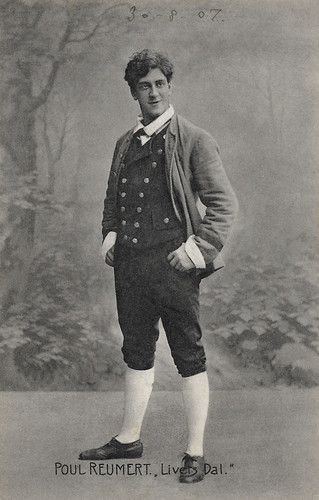
Danish postcard by Forlag Stenders, no. 1064. Poul Reumert in a production of the play 'Livets Dal' (1907) for the Folketeatret.
Exceding the theatre's greatest expectations
Poul Hagen Reumert was born in 1883 in Copenhagen. He was the son of Elith Reumert and Athalia Flammé.
In 1901 Reumert was admitted to the Royal Academy of Music. Theatre, and in 1902 he made his debut at the Royal Theatre. After that, he was associated with the Folketeatret 1902-1908, but it was at the New Theatre between 1908 and 1911 that he first came to the fore and with great success here as the operetta hero in 'Zigøjnerblod' and in 'Dollarprinsessen', in which he had Else Frölich as his partner.
From 1911 to 1918 he was employed at the Royal Theatre. In a few seasons, he made his mark in a way that exceeded the theatre's greatest expectations. His acting embraced an immense range and he became a gripping character actor with countless roles to which he gave new life.
In 1914 he began his legendary collaboration with Bodil Ipsen. Together with the film director Carl Th. Dreyer, Poul Reumert organised an open-air performance of an Offenbach operetta in Dyrehaven around 1919. From 1919 to 1922 he was at the Dagmar Theatre, before returning to the Royal Theatre from 1922 to 1930.
Poul Reumert also made various guest appearances abroad, including in 1925 in Paris at La Comédie Francaise and the Théâtre National de l'Odéon, where he played Moliére in French to great acclaim. He subsequently received offers from both French and English theatres and film companies.
When Adam Poulsen became director of the Royal Theater in 1930 and made a dictatorial speech on taking up his post, Reumert and a number of actors took their leave and went to the Dagmar Theatre, where he was from 1931 to 1937. From 1937 until his death Poul Reumert was again associated with the Royal Theatre.
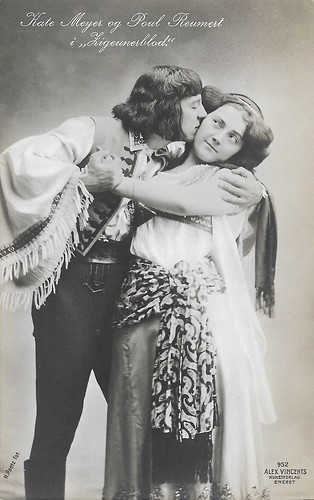
Danish postcard by Alex Vincent's Konstforlag, Eneret, no. 952. Photo: N. Pentz. Poul Reumert and Kate Meyer in the operetta 'Zigeunerblod' ('Zigeunerliebe' by Franz Lehar), performed in 1910 at the Copenhagen New Theater (Det ny Theater).
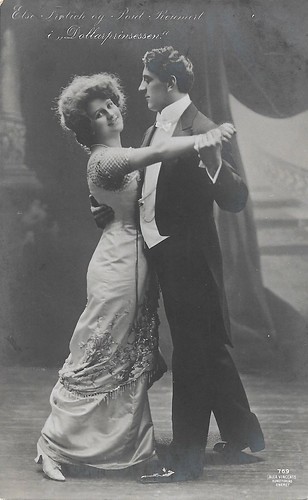
Danish postcard by Alex Vincent's Konstforlag, Eneret, no. 769. Poul Reumert and Else Frölich in the operetta 'Dollarprinzessin' by Leo Fall, performed in 1909 when both were working at the Copenhagen New Theater.
Three waves of film activity
In 1910, Poul Reumert had his film debut in Afgrunden/Abyss (Urban Gad, 1910) opposite Asta Nielsen . The lapdance she performs on him made (film) history. Reumert remained with Gad when the latter moved to Nordisk for Gennem kamp til sejr/Thru Trials to Victory (1911) and Den store flyver/The Aviator's Generosity (1911).
While Gad en Nielsen pursued a career in Germany, Reumert stayed with Nordisk and acted there in films by e.g. Eduard Schnedler-Sörensen, Holger Madsen, and August Blom (Den sorte kansler, 1912 starring Valdemar Psilander , and Bristet Lykke, 1913, starring Olaf Fönss ).
During the First World War, Reumert only did a handful of films, in the 1920s only three and in the 1930s only two. He played the Vicar of Wakefield in David Copperfield (A.W. Sandberg, 1922) and a jeweler in Benjamin Christensen's Swedish film Häxan/Witchcraft Through the Ages (1922).
However, it was during the Second World War that Reumert had a quite active second film career in Danish sound cinema, mostly in comedies by Lau Lauritzen and Alice O'Fredericks. He had the lead in Det brændende Spørgsmaal/The Burning Question (Alice O'Fredericks, 1943), one of the first Danish films to highlight the issue of women and women's rights. Another example is the postwar comedy Familien Swedenhielm/Swedenhielm Family (Lau Lauritzen, 1947) in which he had the lead.
Yet, after an absence of a decade, between 1958 and 1963 Reumert had a third wave of film activity, now in TV movies. He also acted often for the radio.
Poul Reumert passed away in Copenhagen in 1968. He is buried next to his third wife, Anna Borg in Mariebjerg Cemetery.
Poul Reumert's first marriage to Helga Ingeborg Meyer produced three children: Supreme Court lawyer Michael Reumert (1914-1983), actress Vibeke Elisabeth Reumert (1909-2003), and Dyveke Reumert (1911-1998). The marriage was dissolved in 1918. In 1919 Reumert married Rigmor Emmy Julie Reumert, née Dinesen (1893-1978). In 1932 he married the Icelandic actress Anna Borg. His third marriage lasted until Borg's death in 1963. Anna Borg was killed in an Icelandair plane accident at Fornebu Airport near Oslo. They had two children, Stefan (1934) and Torsten (1935).
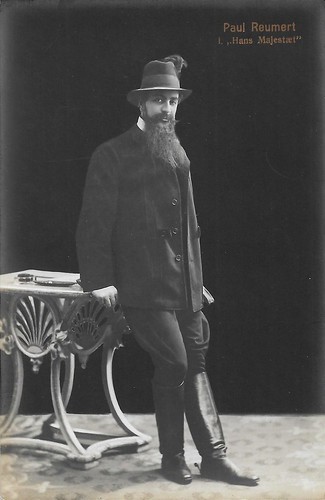
Danish postcard by Müllers Kunstforlag, no. 46. Photo: Juncker Jensen. Poul Reumert in the play 'Hans Majestaet' (His Majesty), in which he starred opposite Ellen Aggerholm at the Fahlstrøms Teater in 1910.
Sources: Wikipedia (Danish and English), , Filmdatabasen, and Danskefilm.dk.

Danish postcard by Forlag Stenders, no. 1064. Poul Reumert in a production of the play 'Livets Dal' (1907) for the Folketeatret.
Exceding the theatre's greatest expectations
Poul Hagen Reumert was born in 1883 in Copenhagen. He was the son of Elith Reumert and Athalia Flammé.
In 1901 Reumert was admitted to the Royal Academy of Music. Theatre, and in 1902 he made his debut at the Royal Theatre. After that, he was associated with the Folketeatret 1902-1908, but it was at the New Theatre between 1908 and 1911 that he first came to the fore and with great success here as the operetta hero in 'Zigøjnerblod' and in 'Dollarprinsessen', in which he had Else Frölich as his partner.
From 1911 to 1918 he was employed at the Royal Theatre. In a few seasons, he made his mark in a way that exceeded the theatre's greatest expectations. His acting embraced an immense range and he became a gripping character actor with countless roles to which he gave new life.
In 1914 he began his legendary collaboration with Bodil Ipsen. Together with the film director Carl Th. Dreyer, Poul Reumert organised an open-air performance of an Offenbach operetta in Dyrehaven around 1919. From 1919 to 1922 he was at the Dagmar Theatre, before returning to the Royal Theatre from 1922 to 1930.
Poul Reumert also made various guest appearances abroad, including in 1925 in Paris at La Comédie Francaise and the Théâtre National de l'Odéon, where he played Moliére in French to great acclaim. He subsequently received offers from both French and English theatres and film companies.
When Adam Poulsen became director of the Royal Theater in 1930 and made a dictatorial speech on taking up his post, Reumert and a number of actors took their leave and went to the Dagmar Theatre, where he was from 1931 to 1937. From 1937 until his death Poul Reumert was again associated with the Royal Theatre.

Danish postcard by Alex Vincent's Konstforlag, Eneret, no. 952. Photo: N. Pentz. Poul Reumert and Kate Meyer in the operetta 'Zigeunerblod' ('Zigeunerliebe' by Franz Lehar), performed in 1910 at the Copenhagen New Theater (Det ny Theater).

Danish postcard by Alex Vincent's Konstforlag, Eneret, no. 769. Poul Reumert and Else Frölich in the operetta 'Dollarprinzessin' by Leo Fall, performed in 1909 when both were working at the Copenhagen New Theater.
Three waves of film activity
In 1910, Poul Reumert had his film debut in Afgrunden/Abyss (Urban Gad, 1910) opposite Asta Nielsen . The lapdance she performs on him made (film) history. Reumert remained with Gad when the latter moved to Nordisk for Gennem kamp til sejr/Thru Trials to Victory (1911) and Den store flyver/The Aviator's Generosity (1911).
While Gad en Nielsen pursued a career in Germany, Reumert stayed with Nordisk and acted there in films by e.g. Eduard Schnedler-Sörensen, Holger Madsen, and August Blom (Den sorte kansler, 1912 starring Valdemar Psilander , and Bristet Lykke, 1913, starring Olaf Fönss ).
During the First World War, Reumert only did a handful of films, in the 1920s only three and in the 1930s only two. He played the Vicar of Wakefield in David Copperfield (A.W. Sandberg, 1922) and a jeweler in Benjamin Christensen's Swedish film Häxan/Witchcraft Through the Ages (1922).
However, it was during the Second World War that Reumert had a quite active second film career in Danish sound cinema, mostly in comedies by Lau Lauritzen and Alice O'Fredericks. He had the lead in Det brændende Spørgsmaal/The Burning Question (Alice O'Fredericks, 1943), one of the first Danish films to highlight the issue of women and women's rights. Another example is the postwar comedy Familien Swedenhielm/Swedenhielm Family (Lau Lauritzen, 1947) in which he had the lead.
Yet, after an absence of a decade, between 1958 and 1963 Reumert had a third wave of film activity, now in TV movies. He also acted often for the radio.
Poul Reumert passed away in Copenhagen in 1968. He is buried next to his third wife, Anna Borg in Mariebjerg Cemetery.
Poul Reumert's first marriage to Helga Ingeborg Meyer produced three children: Supreme Court lawyer Michael Reumert (1914-1983), actress Vibeke Elisabeth Reumert (1909-2003), and Dyveke Reumert (1911-1998). The marriage was dissolved in 1918. In 1919 Reumert married Rigmor Emmy Julie Reumert, née Dinesen (1893-1978). In 1932 he married the Icelandic actress Anna Borg. His third marriage lasted until Borg's death in 1963. Anna Borg was killed in an Icelandair plane accident at Fornebu Airport near Oslo. They had two children, Stefan (1934) and Torsten (1935).

Danish postcard by Müllers Kunstforlag, no. 46. Photo: Juncker Jensen. Poul Reumert in the play 'Hans Majestaet' (His Majesty), in which he starred opposite Ellen Aggerholm at the Fahlstrøms Teater in 1910.
Sources: Wikipedia (Danish and English), , Filmdatabasen, and Danskefilm.dk.
Published on September 12, 2021 22:00
September 11, 2021
Directed by Ingmar Bergman
Ingmar Bergman (1918-2007) was a Swedish film writer and director who achieved world fame with such films as Det sjunde inseglet/The Seventh Seal (1957), Smultronstället/Wild Strawberries (1957), the trilogy Såsom i en spegel/Through a Glass Darkly (1961), Nattsvardsgästerna/Winter Light (1963), and Tystnaden/The Silence (1963), and Viskningar och rop/Cries and Whispers (1972). His final feature, Fanny och Alexander/Fanny and Alexander (1982) won four Academy Awards, including for Best Foreign Language Film. Bergman directed over sixty films and documentaries, most of which he also wrote. He also directed over 170 plays and was the Leading Director of the Royal Dramatic Theatre in Stockholm and of the Residenztheater in Munich.
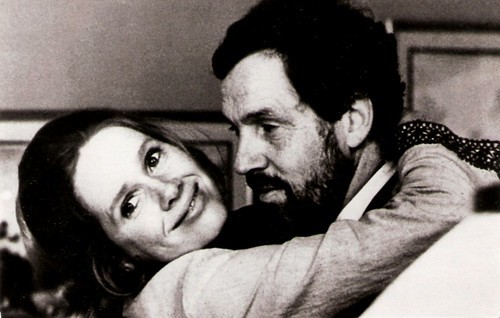
Vintage postcard. Liv Ullmann and Erland Josephson in Scener ur ett äktenskap/Scenes from a Marriage (Ingmar Bergman, 1973).
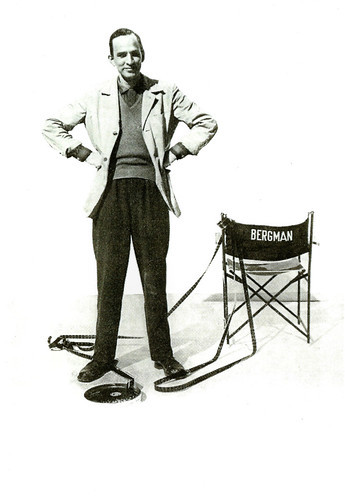
Dutch postcard by Art Unlimited, Amsterdam, no. B 3468. Caption: Ingmar Bergman, photographer unknown, ca. 1963.
A magic lantern traded for a set of tin soldiers
Ernst Ingmar Bergman was born in 1918, in Uppsala, Sweden. He was the second son of Erik Bergman, a Lutheran minister and later chaplain to the King of Sweden, and Karin (née Åkerblom), a nurse. His conservative father had strict ideas of parenting.
John Russell Taylor at Britannica : "he frequently remarked on the importance of his childhood background in the development of his ideas and moral preoccupations. Even when the context of his film characters’ sufferings is not overtly religious, they are always implicitly engaged in a search for moral standards of judgment, a rigorous examination of action and motive, in terms of good and bad, right and wrong, which seems particularly appropriate to someone brought up in a strictly religious home. Another important influence in his childhood was the religious art Bergman encountered, particularly the primitive yet graphic representations of Bible stories and parables found in rustic Swedish churches, which fascinated him and gave him a vital interest in the visual presentation of ideas, especially the idea of evil as embodied in the Devil."
His interest in theatre and film began early. At the age of nine, he traded a set of tin soldiers for a magic lantern, a possession that altered the course of his life. Within a year, he had created, by playing with this toy, a private world in which he felt completely at home, he recalled. He fashioned his own scenery, marionettes, and lighting effects and gave puppet productions of Strindberg plays in which he spoke all the parts.
Bergman attended Palmgren's School as a teenager, and in 1937 Stockholm University, where he studied art, history, and literature. There, for the first time, he became passionately involved in the theatre and began writing and acting in plays and staged his first plays, among them adaptations of William Shakespeare's 'Macbeth', August Strindberg's 'Lucky Peter's Journey' and 'Master Olaf', and Maurice Maeterlinck's 'The Blue Bird'.
In 1939, Bergman accepted the job of production assistant at the Kungliga Dramatiska Teatern (the Royal Theatre in Stockholm), leaving school the following year to focus on stage work. From there, he went on to become a trainee director at the Mäster Olofsgärden Theatre and the Sagas Theatre. In 1941 he produced a spectacularly unconventional and disastrous production of the Swedish playwright August Strindberg’s 'The Ghost Sonata'. That year he also wrote the play 'Kaspers död' (Kaspers Death) which was produced the same year. In 1944 he was given his first full-time job as a stage director, at Helsingborg’s municipal theatre.
'Kaspers död' became his entrance into the film business as Stina Bergman, from the company Svensk Filmindustri (Swedish Filmindustry), saw the play and introduced him to Carl-Anders Dymling, the head of S.F. Bergman started to rewrite scripts. Dymling commissioned him to commission an original screenplay, Hets/Frenzy (1944). This was directed by Alf Sjöberg, then Sweden’s leading film director, and Bergman was appointed as his assistant director. Because Sjöberg was busy, Bergman got the order to shoot the last sequence of the film. Hets was an enormous success and sparked debate on Swedish formal education. As a result of the international success of the film, Bergman was given a chance to write and direct a film of his own, Kris/Crisis (1946), and from this point on his career was underway.
The original trailer in high definition of Sommaren med Monika/Summer with Monika (1953), starring Harriet Andersson, Lars Ekborg and Dagmar Ebbesen. Source: HD Retro Trailers (YouTube).
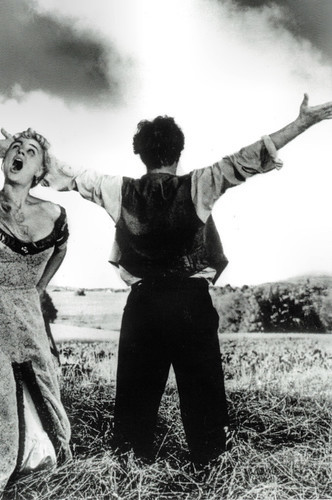
French postcard fort the French DVD release by Dark Star / Carlotta. Photo: AV Svenska Film Industr. Harriet Andersson and Åke Fridel in Sommarnattens leende/Smiles of a Summer Night (Ingmar Bergman, 1955).
Gathering a faithful stock company of actors around him
During the following ten years, Ingmar Bergman wrote and directed more than a dozen films. His next four films, Det Regnar på Vår Kärlek/It Rains on Our Love (1946), Skepp till Indialand/A Ship Bound for India (1947), Musik i Mörker/Night Is My Future (1948), and Hamnstad/Port of Call (1948), were all adaptations.
Fängelse/Prison (1949), Gycklarnas afton/Sawdust and Tinsel (1953), and Sommaren med Monika/Summer with Monika (1953), were, if not directly autobiographical, at least very much concerned with the sort of problems that he himself was encountering at that time: the role of the young in a changing society, ill-fated young love, and military service. Fängelse (1949) recapitulated all the themes of his previous films in a story, built around the romantic and professional problems of a young film director who considers making a film based on the idea that the Devil rules the world.
John Russell Taylor: "While this is not to be taken without qualification as Bergman’s message in his early work, it may at least be said that his imaginative world is divided very sharply between the worlds of good and evil, the latter always overshadowing the former, the Devil lying in wait at the end of each idyll."
In 1951 Bergman’s career in films, like nearly the whole of Swedish filmmaking, came to an abrupt halt as the result of a major economic crisis and a ten-month strike by studio personnel, intended as a protest against an 'amusement tax' levied against film producers. But in 1952 he returned with the film Kvinnors väntan/Waiting Women, which was followed by Sommaren med Monika/Summer with Monika (1953). These films marked the beginning of his mature work.
In 1952 he also was appointed director of the Malmö municipal theatre, where he remained until 1959. This new phase introduced two markedly new characteristics in his work. In subject matter, Bergman, now himself married, returned again and again to the question of marriage. Viewing it from many angles, he examined the ways by which two people adjust to living together, their motives for being faithful or unfaithful to each other, and their reactions to bringing children into the world.
At this time Bergman began to gather around him, in his film and stage productions, a faithful stock company of actors - including Bibi Andersson , Gunnar Björnstrand, Eva Dahlbeck, Erland Josephson, Ingrid Thulin, Liv Ullmann, and Max von Sydow - with whom he worked regularly to give his work and their interpretation of it a manifest consistency and style.
Official Trailer for Det sjunde inseglet/The Seventh Seal (1957). Source: The Cultbox (YouTube).
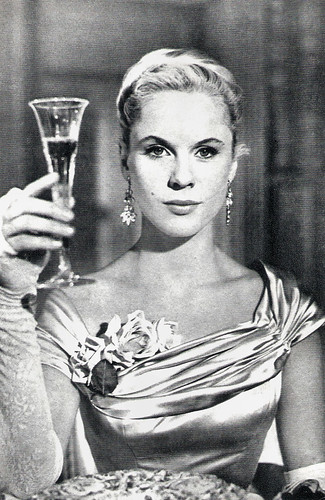
Romanian postcard by Casa Filmului Acin, no. 53. Photo: Bibi Andersson in Smultronstället/Wild Strawberries (Ingmar Bergman, 1957).
A kind of Bergman fever swept over the international film scene
In 1955 Ingmar Bergman had his first great international success with Sommernattens leende/Smiles of a Summer Night (1955), a bittersweet romantic comedy-drama in a period setting. It was nominated for the Palme d'Or at Cannes the following year.
In the next few years, a kind of Bergman fever swept over the international film scene: two masterpieces - Det sjunde inseglet/The Seventh Seal (1957), a medieval morality play, and Smultronstället/Wild Strawberries (1957), a meditation on old age - were released in Sweden ten months apart in 1957. Det sjunde inseglet won a special jury prize and was nominated for the Palme d'Or at Cannes, and Smultronstället won numerous awards for Bergman and its star, Victor Sjöström .
All of his early work was shown, and Bergman was universally recognized as one of the most important figures in cinema. Indeed, a far wider section of the cultured public became aware of his work than of that of any previous filmmaker. For the first time, a filmmaker was as widely and as highly regarded as artists in any of the more traditional media. Inevitably, a reaction set in, though Bergman continued to make films and direct plays with undiminished activity.
In the early 1960s he directed three films that explored the theme of faith and doubt in God, Såsom i en Spegel/Through a Glass Darkly (1961), Nattvardsgästerna/Winter Light (1962), and Tystnaden/The Silence (1963). This trilogy was regarded by many as his crowning achievement. Through a Glass Darkly won an Academy Award for best foreign film.
About this time, Bergman acquired a country home on the bleak island of Fårö, Sweden, and the island provided a characteristic stage for the dramas of a whole series of films that included Persona (1966), Vargtimmen/Hour of the Wolf (1968), Skammen/Shame (1968), and En passion/A Passion (1969), all dramas of inner conflicts involving a small, closely-knit group of characters.
With Beröringen/The Touch (1971), his first English-language film, Bergman returned to an urban setting and more romantic subject matter, though fundamentally the characters in the film’s marital triangle are no less mixed up than any in the Fårö cycle of films. And then Viskningar och rop/Cries and Whispers (1972), Scener ur ett äktenskap/Scenes from a Marriage (1973), and Höstsonaten/Autumn Sonata (1978), all dealing compassionately with intimate family relationships, won popular as well as critical fame. With his cinematographer Sven Nykvist, Bergman made use of a crimson colour scheme for Cries and Whispers (1972), which received a nomination for the Academy Award for Best Picture.
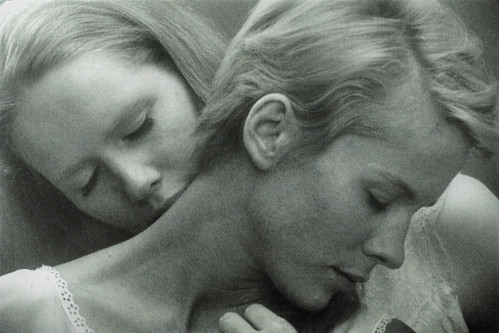
French postcard for the French DVD release by Dark Star / Carlotta. Photo: Bo Arne Vibenius / AV Svenska Film Industri. Liv Ullmann and Bibi Andersson in Persona (Ingmar Bergman, 1966).
The original trailer in high definition of Viskningar och rop/Cries and Whispers (1972), starring Harriet Andersson, Ingrid Thulin, Liv Ullmann, and Kari Sylwan. Source: HD Retro Trailers.
Arrested by two plainclothes police officers and charged with income tax evasion
Through the years, Ingmar Bergman continued to direct for the stage, most notably at Stockholm’s Royal Dramatic Theatre. He also produced extensively for Swedish television at this time. Two works of note were Scener ur ett äktenskap/Scenes from a Marriage (1973) and Trollflöjten/The Magic Flute (1975).
On 30 January 1976, while rehearsing August Strindberg's 'The Dance of Death' at the Royal Dramatic Theatre, he was arrested by two plainclothes police officers and charged with income tax evasion. On 23 March 1976, the special prosecutor Anders Nordenadler dropped the charges against Bergman, saying that the alleged crime had no legal basis. The impact of the event on Bergman was devastating. He suffered a nervous breakdown as a result of the humiliation and was hospitalised in a state of deep depression.
Despite pleas by the Swedish prime minister Olof Palme, high public figures, and leaders of the film industry, Bergman vowed never to work in Sweden again. He went into self-imposed exile in Munich, Germany. His next film, The Serpent's Egg (1977) was a German-U.S. production. This was followed by a British-Norwegian co-production, Höstsonaten/Autumn Sonata (1978) starring Ingrid Bergman , and Aus dem Leben der Marionetten/From the Life of the Marionettes (1980) which was a British-German co-production.
In 1977 he received the Swedish Academy of Letters Great Gold Medal, and in the following year, the Swedish Film Institute established a prize for excellence in filmmaking in his name. He temporarily returned to his homeland to direct Fanny och Alexander/Fanny and Alexander (1982), in which the fortunes and misfortunes of a wealthy theatrical family in turn-of-the-century Sweden are portrayed through the eyes of a young boy. The film earned an Academy Award for best foreign film. In 1991 Bergman received the Japan Art Association’s Praemium Imperiale prize for theatre/film.
Bergman also directed a number of television films, notably the critically acclaimed Saraband (2003), directed by Bergman when he was 84 years old. It featured the main characters from Scenes from a Marriage, and the film received a theatrical release. In addition, he wrote several novels, including 'Söndagsbarn' (1993; Sunday’s Children) and 'Enskilda samtal' (1996; Private Confessions), that were made into films. His memoir, 'Laterna magica' (The Magic Lantern), was published in 1987.
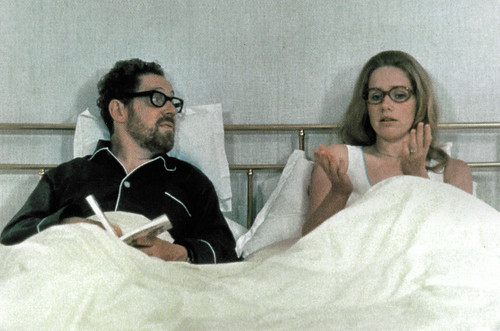
French postcard fort the French DVD release by Dark Star / Carlotta. Photo: AV Svenska Film Industr. Erland Josephson and Liv Ullmann in Scener ur ett äktenskap/Scenes from a Marriage (Ingmar Bergman, 1973).
The original trailer in high definition of Höstsonaten/Autumn Sonata (1978), starring Ingrid Bergman , Liv Ullmann, and Lena Nyman. Source: HD Retro Trailers.
Creating an abstract drama of human relationships
In 2007, Ingmar Bergman died peacefully in his sleep on the island of Fårö. He was 89. Bergman had been married five times: to choreographer and dancer Else Fisher (1943-1945), to choreographer and film director Ellen Lundström (1945-1950), to journalist Gun Grut (1951-1959), to concert pianist Käbi Laretei (1959-1969), and to Ingrid von Rosen (1971-1995). The first four marriages ended in divorce, while the last ended when his wife Ingrid died of stomach cancer in 1995, aged 65. Aside from his marriages, Bergman had romantic relationships with actresses Harriet Andersson (1952-1955), Bibi Andersson (1955-1959), and Liv Ullmann (1965-1970). He had nine children.
After Ingmar Bergman died, a large archive of notes was donated to the Swedish Film Institute. Bergman established a worldwide reputation for writing and directing films that, in an unmistakably individual style, examine the issues of morality by exploring human relationships, with others and with God. His work and the worldwide vogue it enjoyed in the late 1950s and early 1960s introduced many people for the first time to the idea of the total filmmaker, the writer-director who throughout a sizable body of work used the medium of film to express his own ideas and perceptions, with as much ease and conviction as artists in earlier generations used the novel or the symphony or the fresco.
The immense international popularity of his films tended to ensure that Bergman’s picture of Sweden and the Swedish temperament was the first and often the only impression received by the outside world. When other Swedish films seem to present much the same image, it is usually because the influence of Bergman on his Swedish colleagues was so pervasive rather than because his highly personal vision should be taken as an objectively true portrait of his country.
Jason Ankeny at AllMovie : "Ingmar Bergman radically altered the nature and meaning of the motion-picture form, transfiguring a medium long devoted to spectacle into an art capable of profoundly personal meditations into the myriad struggles facing the psyche and the soul."
John Russell Taylor: "Bergman’s anguished appraisal of the human situation lost nothing of its intensity through the years. Rather, he progressively stripped away the distracting decorations in his films to create an abstract drama of human relationships, with others and perhaps with God (if God exists). He dealt with the human attempt to define one’s own personality by the removal of masks to see if there is a face underneath. The images of the creator as an actor and the creator as a magician recur throughout Bergman’s work. He himself embodied elements of both the thinker and the actor, the preacher and the charlatan. In Bergman, they all fused to create an artist of great force and individuality whose work is always unmistakably his own."
The original trailer in high definition of Fanny och Alexander/Fanny and Alexander (1982), starring Bertil Guve, Pernilla Allwin, and Kristina Adolphson. Source: HD Retro Trailers.
Sources: John Russell Taylor (Britannica), Jason Ankeny (AllMovie), Wikipedia, and .

Vintage postcard. Liv Ullmann and Erland Josephson in Scener ur ett äktenskap/Scenes from a Marriage (Ingmar Bergman, 1973).

Dutch postcard by Art Unlimited, Amsterdam, no. B 3468. Caption: Ingmar Bergman, photographer unknown, ca. 1963.
A magic lantern traded for a set of tin soldiers
Ernst Ingmar Bergman was born in 1918, in Uppsala, Sweden. He was the second son of Erik Bergman, a Lutheran minister and later chaplain to the King of Sweden, and Karin (née Åkerblom), a nurse. His conservative father had strict ideas of parenting.
John Russell Taylor at Britannica : "he frequently remarked on the importance of his childhood background in the development of his ideas and moral preoccupations. Even when the context of his film characters’ sufferings is not overtly religious, they are always implicitly engaged in a search for moral standards of judgment, a rigorous examination of action and motive, in terms of good and bad, right and wrong, which seems particularly appropriate to someone brought up in a strictly religious home. Another important influence in his childhood was the religious art Bergman encountered, particularly the primitive yet graphic representations of Bible stories and parables found in rustic Swedish churches, which fascinated him and gave him a vital interest in the visual presentation of ideas, especially the idea of evil as embodied in the Devil."
His interest in theatre and film began early. At the age of nine, he traded a set of tin soldiers for a magic lantern, a possession that altered the course of his life. Within a year, he had created, by playing with this toy, a private world in which he felt completely at home, he recalled. He fashioned his own scenery, marionettes, and lighting effects and gave puppet productions of Strindberg plays in which he spoke all the parts.
Bergman attended Palmgren's School as a teenager, and in 1937 Stockholm University, where he studied art, history, and literature. There, for the first time, he became passionately involved in the theatre and began writing and acting in plays and staged his first plays, among them adaptations of William Shakespeare's 'Macbeth', August Strindberg's 'Lucky Peter's Journey' and 'Master Olaf', and Maurice Maeterlinck's 'The Blue Bird'.
In 1939, Bergman accepted the job of production assistant at the Kungliga Dramatiska Teatern (the Royal Theatre in Stockholm), leaving school the following year to focus on stage work. From there, he went on to become a trainee director at the Mäster Olofsgärden Theatre and the Sagas Theatre. In 1941 he produced a spectacularly unconventional and disastrous production of the Swedish playwright August Strindberg’s 'The Ghost Sonata'. That year he also wrote the play 'Kaspers död' (Kaspers Death) which was produced the same year. In 1944 he was given his first full-time job as a stage director, at Helsingborg’s municipal theatre.
'Kaspers död' became his entrance into the film business as Stina Bergman, from the company Svensk Filmindustri (Swedish Filmindustry), saw the play and introduced him to Carl-Anders Dymling, the head of S.F. Bergman started to rewrite scripts. Dymling commissioned him to commission an original screenplay, Hets/Frenzy (1944). This was directed by Alf Sjöberg, then Sweden’s leading film director, and Bergman was appointed as his assistant director. Because Sjöberg was busy, Bergman got the order to shoot the last sequence of the film. Hets was an enormous success and sparked debate on Swedish formal education. As a result of the international success of the film, Bergman was given a chance to write and direct a film of his own, Kris/Crisis (1946), and from this point on his career was underway.
The original trailer in high definition of Sommaren med Monika/Summer with Monika (1953), starring Harriet Andersson, Lars Ekborg and Dagmar Ebbesen. Source: HD Retro Trailers (YouTube).

French postcard fort the French DVD release by Dark Star / Carlotta. Photo: AV Svenska Film Industr. Harriet Andersson and Åke Fridel in Sommarnattens leende/Smiles of a Summer Night (Ingmar Bergman, 1955).
Gathering a faithful stock company of actors around him
During the following ten years, Ingmar Bergman wrote and directed more than a dozen films. His next four films, Det Regnar på Vår Kärlek/It Rains on Our Love (1946), Skepp till Indialand/A Ship Bound for India (1947), Musik i Mörker/Night Is My Future (1948), and Hamnstad/Port of Call (1948), were all adaptations.
Fängelse/Prison (1949), Gycklarnas afton/Sawdust and Tinsel (1953), and Sommaren med Monika/Summer with Monika (1953), were, if not directly autobiographical, at least very much concerned with the sort of problems that he himself was encountering at that time: the role of the young in a changing society, ill-fated young love, and military service. Fängelse (1949) recapitulated all the themes of his previous films in a story, built around the romantic and professional problems of a young film director who considers making a film based on the idea that the Devil rules the world.
John Russell Taylor: "While this is not to be taken without qualification as Bergman’s message in his early work, it may at least be said that his imaginative world is divided very sharply between the worlds of good and evil, the latter always overshadowing the former, the Devil lying in wait at the end of each idyll."
In 1951 Bergman’s career in films, like nearly the whole of Swedish filmmaking, came to an abrupt halt as the result of a major economic crisis and a ten-month strike by studio personnel, intended as a protest against an 'amusement tax' levied against film producers. But in 1952 he returned with the film Kvinnors väntan/Waiting Women, which was followed by Sommaren med Monika/Summer with Monika (1953). These films marked the beginning of his mature work.
In 1952 he also was appointed director of the Malmö municipal theatre, where he remained until 1959. This new phase introduced two markedly new characteristics in his work. In subject matter, Bergman, now himself married, returned again and again to the question of marriage. Viewing it from many angles, he examined the ways by which two people adjust to living together, their motives for being faithful or unfaithful to each other, and their reactions to bringing children into the world.
At this time Bergman began to gather around him, in his film and stage productions, a faithful stock company of actors - including Bibi Andersson , Gunnar Björnstrand, Eva Dahlbeck, Erland Josephson, Ingrid Thulin, Liv Ullmann, and Max von Sydow - with whom he worked regularly to give his work and their interpretation of it a manifest consistency and style.
Official Trailer for Det sjunde inseglet/The Seventh Seal (1957). Source: The Cultbox (YouTube).

Romanian postcard by Casa Filmului Acin, no. 53. Photo: Bibi Andersson in Smultronstället/Wild Strawberries (Ingmar Bergman, 1957).
A kind of Bergman fever swept over the international film scene
In 1955 Ingmar Bergman had his first great international success with Sommernattens leende/Smiles of a Summer Night (1955), a bittersweet romantic comedy-drama in a period setting. It was nominated for the Palme d'Or at Cannes the following year.
In the next few years, a kind of Bergman fever swept over the international film scene: two masterpieces - Det sjunde inseglet/The Seventh Seal (1957), a medieval morality play, and Smultronstället/Wild Strawberries (1957), a meditation on old age - were released in Sweden ten months apart in 1957. Det sjunde inseglet won a special jury prize and was nominated for the Palme d'Or at Cannes, and Smultronstället won numerous awards for Bergman and its star, Victor Sjöström .
All of his early work was shown, and Bergman was universally recognized as one of the most important figures in cinema. Indeed, a far wider section of the cultured public became aware of his work than of that of any previous filmmaker. For the first time, a filmmaker was as widely and as highly regarded as artists in any of the more traditional media. Inevitably, a reaction set in, though Bergman continued to make films and direct plays with undiminished activity.
In the early 1960s he directed three films that explored the theme of faith and doubt in God, Såsom i en Spegel/Through a Glass Darkly (1961), Nattvardsgästerna/Winter Light (1962), and Tystnaden/The Silence (1963). This trilogy was regarded by many as his crowning achievement. Through a Glass Darkly won an Academy Award for best foreign film.
About this time, Bergman acquired a country home on the bleak island of Fårö, Sweden, and the island provided a characteristic stage for the dramas of a whole series of films that included Persona (1966), Vargtimmen/Hour of the Wolf (1968), Skammen/Shame (1968), and En passion/A Passion (1969), all dramas of inner conflicts involving a small, closely-knit group of characters.
With Beröringen/The Touch (1971), his first English-language film, Bergman returned to an urban setting and more romantic subject matter, though fundamentally the characters in the film’s marital triangle are no less mixed up than any in the Fårö cycle of films. And then Viskningar och rop/Cries and Whispers (1972), Scener ur ett äktenskap/Scenes from a Marriage (1973), and Höstsonaten/Autumn Sonata (1978), all dealing compassionately with intimate family relationships, won popular as well as critical fame. With his cinematographer Sven Nykvist, Bergman made use of a crimson colour scheme for Cries and Whispers (1972), which received a nomination for the Academy Award for Best Picture.

French postcard for the French DVD release by Dark Star / Carlotta. Photo: Bo Arne Vibenius / AV Svenska Film Industri. Liv Ullmann and Bibi Andersson in Persona (Ingmar Bergman, 1966).
The original trailer in high definition of Viskningar och rop/Cries and Whispers (1972), starring Harriet Andersson, Ingrid Thulin, Liv Ullmann, and Kari Sylwan. Source: HD Retro Trailers.
Arrested by two plainclothes police officers and charged with income tax evasion
Through the years, Ingmar Bergman continued to direct for the stage, most notably at Stockholm’s Royal Dramatic Theatre. He also produced extensively for Swedish television at this time. Two works of note were Scener ur ett äktenskap/Scenes from a Marriage (1973) and Trollflöjten/The Magic Flute (1975).
On 30 January 1976, while rehearsing August Strindberg's 'The Dance of Death' at the Royal Dramatic Theatre, he was arrested by two plainclothes police officers and charged with income tax evasion. On 23 March 1976, the special prosecutor Anders Nordenadler dropped the charges against Bergman, saying that the alleged crime had no legal basis. The impact of the event on Bergman was devastating. He suffered a nervous breakdown as a result of the humiliation and was hospitalised in a state of deep depression.
Despite pleas by the Swedish prime minister Olof Palme, high public figures, and leaders of the film industry, Bergman vowed never to work in Sweden again. He went into self-imposed exile in Munich, Germany. His next film, The Serpent's Egg (1977) was a German-U.S. production. This was followed by a British-Norwegian co-production, Höstsonaten/Autumn Sonata (1978) starring Ingrid Bergman , and Aus dem Leben der Marionetten/From the Life of the Marionettes (1980) which was a British-German co-production.
In 1977 he received the Swedish Academy of Letters Great Gold Medal, and in the following year, the Swedish Film Institute established a prize for excellence in filmmaking in his name. He temporarily returned to his homeland to direct Fanny och Alexander/Fanny and Alexander (1982), in which the fortunes and misfortunes of a wealthy theatrical family in turn-of-the-century Sweden are portrayed through the eyes of a young boy. The film earned an Academy Award for best foreign film. In 1991 Bergman received the Japan Art Association’s Praemium Imperiale prize for theatre/film.
Bergman also directed a number of television films, notably the critically acclaimed Saraband (2003), directed by Bergman when he was 84 years old. It featured the main characters from Scenes from a Marriage, and the film received a theatrical release. In addition, he wrote several novels, including 'Söndagsbarn' (1993; Sunday’s Children) and 'Enskilda samtal' (1996; Private Confessions), that were made into films. His memoir, 'Laterna magica' (The Magic Lantern), was published in 1987.

French postcard fort the French DVD release by Dark Star / Carlotta. Photo: AV Svenska Film Industr. Erland Josephson and Liv Ullmann in Scener ur ett äktenskap/Scenes from a Marriage (Ingmar Bergman, 1973).
The original trailer in high definition of Höstsonaten/Autumn Sonata (1978), starring Ingrid Bergman , Liv Ullmann, and Lena Nyman. Source: HD Retro Trailers.
Creating an abstract drama of human relationships
In 2007, Ingmar Bergman died peacefully in his sleep on the island of Fårö. He was 89. Bergman had been married five times: to choreographer and dancer Else Fisher (1943-1945), to choreographer and film director Ellen Lundström (1945-1950), to journalist Gun Grut (1951-1959), to concert pianist Käbi Laretei (1959-1969), and to Ingrid von Rosen (1971-1995). The first four marriages ended in divorce, while the last ended when his wife Ingrid died of stomach cancer in 1995, aged 65. Aside from his marriages, Bergman had romantic relationships with actresses Harriet Andersson (1952-1955), Bibi Andersson (1955-1959), and Liv Ullmann (1965-1970). He had nine children.
After Ingmar Bergman died, a large archive of notes was donated to the Swedish Film Institute. Bergman established a worldwide reputation for writing and directing films that, in an unmistakably individual style, examine the issues of morality by exploring human relationships, with others and with God. His work and the worldwide vogue it enjoyed in the late 1950s and early 1960s introduced many people for the first time to the idea of the total filmmaker, the writer-director who throughout a sizable body of work used the medium of film to express his own ideas and perceptions, with as much ease and conviction as artists in earlier generations used the novel or the symphony or the fresco.
The immense international popularity of his films tended to ensure that Bergman’s picture of Sweden and the Swedish temperament was the first and often the only impression received by the outside world. When other Swedish films seem to present much the same image, it is usually because the influence of Bergman on his Swedish colleagues was so pervasive rather than because his highly personal vision should be taken as an objectively true portrait of his country.
Jason Ankeny at AllMovie : "Ingmar Bergman radically altered the nature and meaning of the motion-picture form, transfiguring a medium long devoted to spectacle into an art capable of profoundly personal meditations into the myriad struggles facing the psyche and the soul."
John Russell Taylor: "Bergman’s anguished appraisal of the human situation lost nothing of its intensity through the years. Rather, he progressively stripped away the distracting decorations in his films to create an abstract drama of human relationships, with others and perhaps with God (if God exists). He dealt with the human attempt to define one’s own personality by the removal of masks to see if there is a face underneath. The images of the creator as an actor and the creator as a magician recur throughout Bergman’s work. He himself embodied elements of both the thinker and the actor, the preacher and the charlatan. In Bergman, they all fused to create an artist of great force and individuality whose work is always unmistakably his own."
The original trailer in high definition of Fanny och Alexander/Fanny and Alexander (1982), starring Bertil Guve, Pernilla Allwin, and Kristina Adolphson. Source: HD Retro Trailers.
Sources: John Russell Taylor (Britannica), Jason Ankeny (AllMovie), Wikipedia, and .
Published on September 11, 2021 22:00
September 10, 2021
Josep Caklovic
in the 1920s, Josep Caklovic was an editor of film postcards in Zagreb, then the Kingdom of Yugoslavia, now Croatia. He published postcards of film stars and scenes for the Yugoslavian film production and distribution companies Mosinger, Pan-Film, Balkan-Film, and others. Caklovic started probably with his production in 1923. Early Caklovic postcards included those for Mosinger to promote the French Albatros film Le Prince Charmant, for Pan-Film for the German films Garragan with Carmel Myers and Der Gardeoffizier with Maria Corda, and for Balkan-Film for Fritz Lang's masterpiece Die Nibelungen. Postcards with the Yugoslavian star Steffi Vidacic were also included. Two series exist of the Caklovic cards: those with the name 'Ed. Caklovic' and numbers on the front, and those with the name (logo) 'Jos. Caklovic, Zagreb' and numbers on the back.
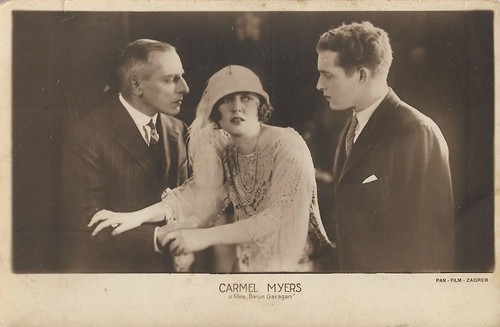
Yugoslavian postcard by Jos. Caklovic, Zagreb, Bromografija, no. 5. Photo: Pan-Film Zagreb. Carmel Myers in Garragan (Ludwig Wolff, 1924), starring Edward Burns and Myers.
Ludwig Wolff also produced and scripted the film, while the script was based on a novel by Wolff himself. Wolff did this multitasking more often. Garragan treats one of Wolff's favourite themes, that of reincarnation. Baron Garragan, who has been rightly condemned to ten years in prison for murdering a man he believed to be his wife's lover. Then he is released...
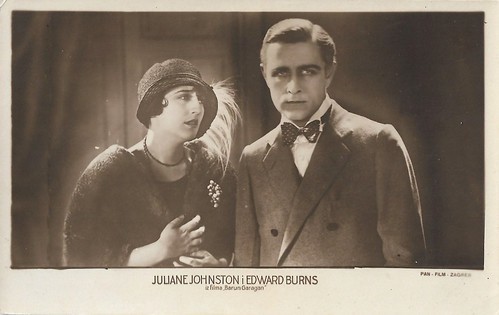
Yugoslavian postcard by Jos. Caklovic, Zagreb, Bromografija, no. 6. Photo: Pan-Film Zagreb. Julanne Johnston (aka Julianne Johnston) and Edward Burns in Garragan (Ludwig Wolff, 1924).
In between the shooting of Ben-Hur in Italy, Hollywood actress Carmel Myers and two other American actors, Edward Burns, and Julanne aka Julianne Johnston became the protagonists of the German production Garrigan. Not much about the film is known. While for Myers it was her only European role, Johnston stayed on in Germany to have a female lead, with Olga Tschechowa, in Die Stadt der Versuchung (Walter Niebuhr, 1925) and Burns had a leading role in Der Farmer aus Texas (Joe May, 1924-1925). Johnston just had had a major role as the princess in The Thief of Bagdad, starring Douglas Fairbanks, while Myers would reach stardom as the seductive Iras in Ben-Hur (1925). Instead, Burns was an unlikely lead, as he had mostly been a supporting actor in American Westerns for Universal or small companies.
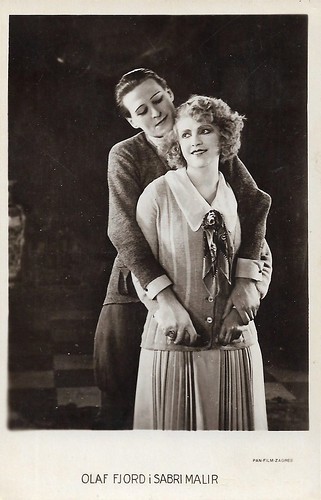
Yugoslavian postcard by Jos. Caklovic, Zagreb, no 16. Photo: Pan-Film, Zagreb. Olaf Fjord and Sabri Mahir in Der gestohlene Professor (Emil Justitz, 1924). It was her only film role.
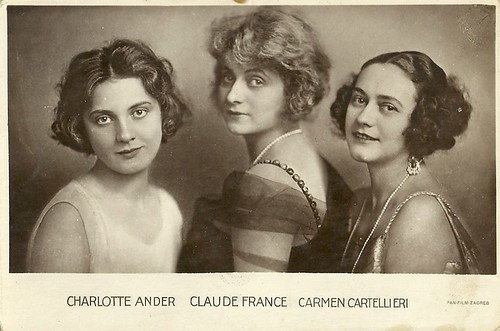
Yugoslavian postcard by Jos. Caklovic, Zagreb, no 23. Photo: Pan-Film, Zagreb. Charlotte Ander , Claude France , and Carmen Cartellieri .
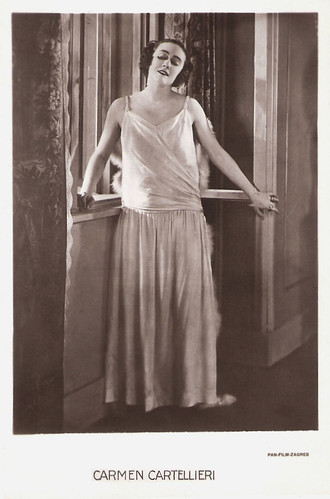
Yugoslavian postcard by Jos. Caklovic, Zagreb, no. 26. Photo: Pan-Film, Zagreb. Carmen Cartellieri (1891-1953) was a film actress of the Hungarian, Austrian and German silent cinema of the 1920s.
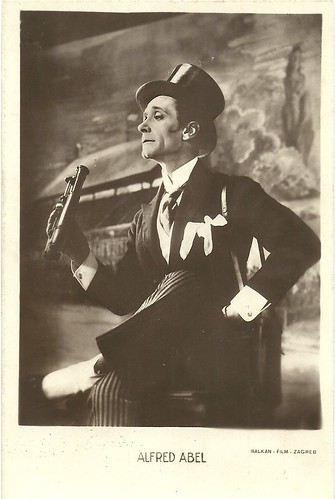
Yugoslavian postcard by Jos. Caklovic, Zagreb, no. 37. Photo: Balkan Film, Zagreb. Alfred Abel in Die Finanzen des Großherzogs (F. W. Murnau, 1924). Collection: Didier Hanson.
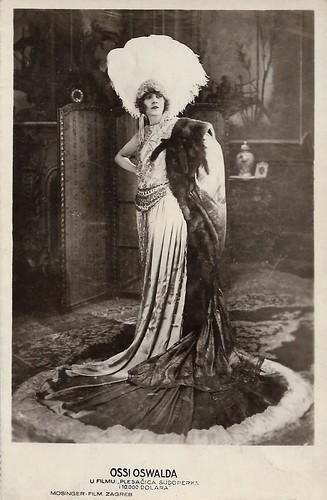
Yugoslavian postcard by Jos. Caklovic, Zagreb, no 43. Photo: Mosinger Film, Zagreb. Ossi Oswalda in Niniche (Victor Janson, 1925).
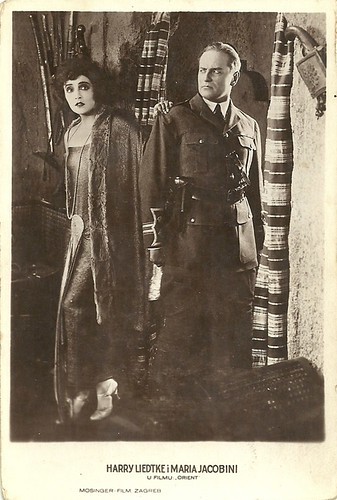
Yugoslavian postcard by Jos. Caklovic, Zagreb, no 44. Photo: Mosinger Film, Zagreb. Maria Jacobini and Harry Liedtke in Orient - Die Tochter der Wüste (Gennaro Righelli, 1924).
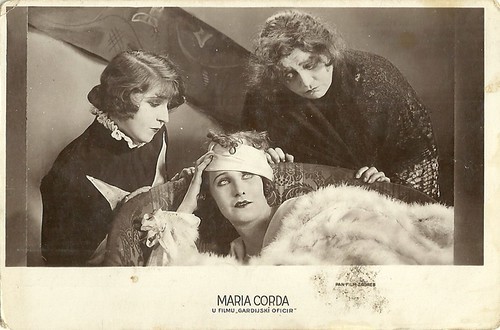
Yugoslavian postcard by Jos. Caklovic, Zagreb, no 57. Photo: Pan Film, Zagreb. Maria Corda in the German film Der Gardeoffizier (Robert Wiene, 1927), based on the play 'A testör' by Ferenc Molnár.
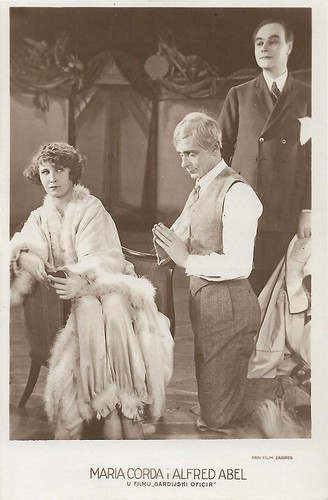
Yugoslavian postcard by Jos. Caklovic, Zagreb, no 59. Photo: Pan Film, Zagreb. Maria Corda and Alfred Abel in Der Gardeoffizier (Robert Wiene, 1927)r. The man kneeling and begging for forgiveness is Abel. The man in the back is possibly Anton Edthofer, who plays a critic.
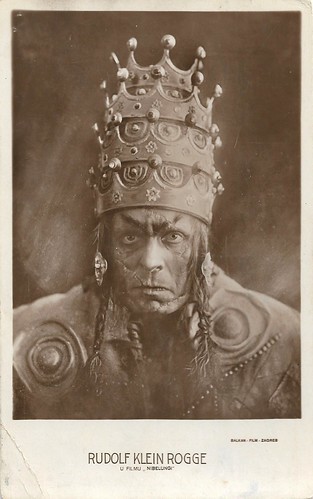
Yugoslavian postcard by Jos. Caklovic, Zagreb, no 65. Photo: Balkan-Film, Zagreb. Rudolf Klein-Rogge as Lord Etzel, King of the Huns, in Fritz Lang's medieval legend Die Nibelungen (1924).
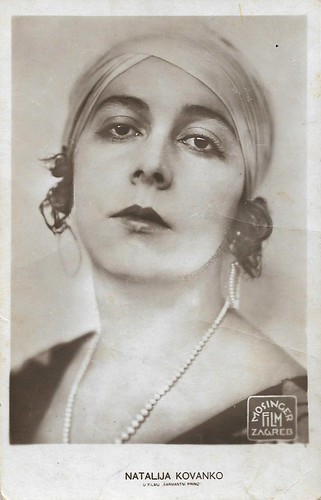
Yugoslavian postcard by Jos. Caklovic, Zagreb, no 72. Photo: Mosinger Film, Zagreb. Nathalie Kovanko in Le prince charmant/Prince Charming (Viktor Tourjansky, 1925).
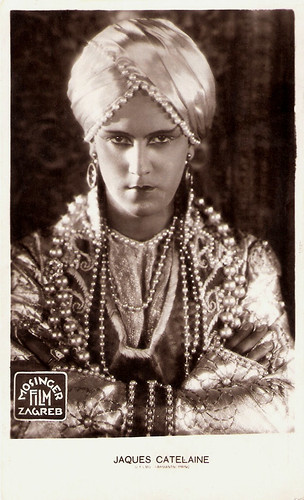
Yugoslavian postcard by Jos. Caklovic, Zagreb, no. 75. Photo: Mosinger Film, Zagreb. Jaque Catelain in Le prince charmant/Prince Charming (Viktor Tourjansky, 1925).
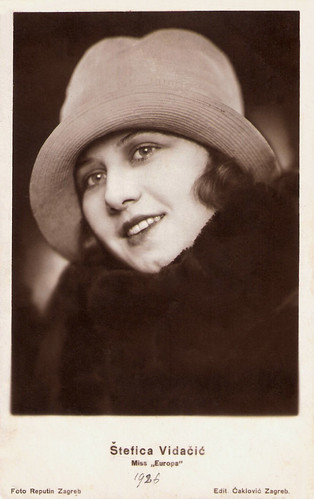
Yugoslavian postcard by Edit. Caklovic, Zagreb. Photo: Reputin, Zagreb. Yugoslavian beauty Štefica Vidačić (1905-?) became Miss Europe 1927. This triumph led to a brief career in the German silent cinema under the stage name Steffie Vida . It made her an idol in Croatia, but her marriage to a Rich German lead to desolate reactions of her male fans in Zagreb.
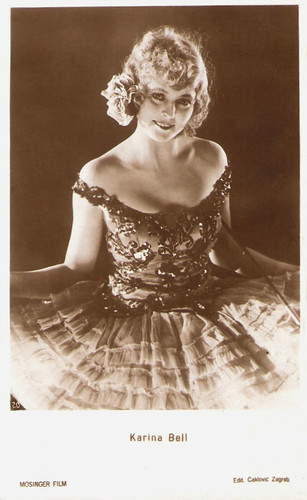
Yugoslavian postcard by Edit. Caklovic, Zagreb, no. 3747/1. Photo: Mosinger Film. Karina Bell in Klovnen/The Clown (A.W. Sandberg, 1926).

Yugoslavian postcard by Jos. Caklovic, Zagreb, Bromografija, no. 5. Photo: Pan-Film Zagreb. Carmel Myers in Garragan (Ludwig Wolff, 1924), starring Edward Burns and Myers.
Ludwig Wolff also produced and scripted the film, while the script was based on a novel by Wolff himself. Wolff did this multitasking more often. Garragan treats one of Wolff's favourite themes, that of reincarnation. Baron Garragan, who has been rightly condemned to ten years in prison for murdering a man he believed to be his wife's lover. Then he is released...

Yugoslavian postcard by Jos. Caklovic, Zagreb, Bromografija, no. 6. Photo: Pan-Film Zagreb. Julanne Johnston (aka Julianne Johnston) and Edward Burns in Garragan (Ludwig Wolff, 1924).
In between the shooting of Ben-Hur in Italy, Hollywood actress Carmel Myers and two other American actors, Edward Burns, and Julanne aka Julianne Johnston became the protagonists of the German production Garrigan. Not much about the film is known. While for Myers it was her only European role, Johnston stayed on in Germany to have a female lead, with Olga Tschechowa, in Die Stadt der Versuchung (Walter Niebuhr, 1925) and Burns had a leading role in Der Farmer aus Texas (Joe May, 1924-1925). Johnston just had had a major role as the princess in The Thief of Bagdad, starring Douglas Fairbanks, while Myers would reach stardom as the seductive Iras in Ben-Hur (1925). Instead, Burns was an unlikely lead, as he had mostly been a supporting actor in American Westerns for Universal or small companies.

Yugoslavian postcard by Jos. Caklovic, Zagreb, no 16. Photo: Pan-Film, Zagreb. Olaf Fjord and Sabri Mahir in Der gestohlene Professor (Emil Justitz, 1924). It was her only film role.

Yugoslavian postcard by Jos. Caklovic, Zagreb, no 23. Photo: Pan-Film, Zagreb. Charlotte Ander , Claude France , and Carmen Cartellieri .

Yugoslavian postcard by Jos. Caklovic, Zagreb, no. 26. Photo: Pan-Film, Zagreb. Carmen Cartellieri (1891-1953) was a film actress of the Hungarian, Austrian and German silent cinema of the 1920s.

Yugoslavian postcard by Jos. Caklovic, Zagreb, no. 37. Photo: Balkan Film, Zagreb. Alfred Abel in Die Finanzen des Großherzogs (F. W. Murnau, 1924). Collection: Didier Hanson.

Yugoslavian postcard by Jos. Caklovic, Zagreb, no 43. Photo: Mosinger Film, Zagreb. Ossi Oswalda in Niniche (Victor Janson, 1925).

Yugoslavian postcard by Jos. Caklovic, Zagreb, no 44. Photo: Mosinger Film, Zagreb. Maria Jacobini and Harry Liedtke in Orient - Die Tochter der Wüste (Gennaro Righelli, 1924).

Yugoslavian postcard by Jos. Caklovic, Zagreb, no 57. Photo: Pan Film, Zagreb. Maria Corda in the German film Der Gardeoffizier (Robert Wiene, 1927), based on the play 'A testör' by Ferenc Molnár.

Yugoslavian postcard by Jos. Caklovic, Zagreb, no 59. Photo: Pan Film, Zagreb. Maria Corda and Alfred Abel in Der Gardeoffizier (Robert Wiene, 1927)r. The man kneeling and begging for forgiveness is Abel. The man in the back is possibly Anton Edthofer, who plays a critic.

Yugoslavian postcard by Jos. Caklovic, Zagreb, no 65. Photo: Balkan-Film, Zagreb. Rudolf Klein-Rogge as Lord Etzel, King of the Huns, in Fritz Lang's medieval legend Die Nibelungen (1924).

Yugoslavian postcard by Jos. Caklovic, Zagreb, no 72. Photo: Mosinger Film, Zagreb. Nathalie Kovanko in Le prince charmant/Prince Charming (Viktor Tourjansky, 1925).

Yugoslavian postcard by Jos. Caklovic, Zagreb, no. 75. Photo: Mosinger Film, Zagreb. Jaque Catelain in Le prince charmant/Prince Charming (Viktor Tourjansky, 1925).

Yugoslavian postcard by Edit. Caklovic, Zagreb. Photo: Reputin, Zagreb. Yugoslavian beauty Štefica Vidačić (1905-?) became Miss Europe 1927. This triumph led to a brief career in the German silent cinema under the stage name Steffie Vida . It made her an idol in Croatia, but her marriage to a Rich German lead to desolate reactions of her male fans in Zagreb.

Yugoslavian postcard by Edit. Caklovic, Zagreb, no. 3747/1. Photo: Mosinger Film. Karina Bell in Klovnen/The Clown (A.W. Sandberg, 1926).
Published on September 10, 2021 22:00
September 9, 2021
Jane Powell (1929-2021)
Jane Powell (1929-2021) was the singing and dancing star of MGM musicals of the 1940s and 1950s. She is best known for her role as Milly in Seven Brides for Seven Brothers (1954).
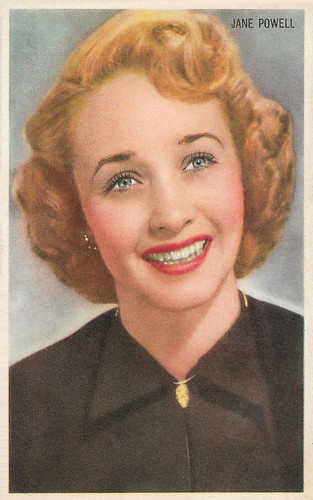
Belgian collectors card by Kwatta, no. C. 288. Photo: MGM. Jane Powell in Nancy Goes to Rio (Robert Z. Leonard, 1950).
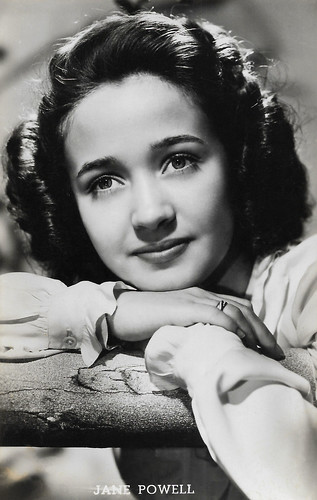
Dutch postcard Van Leer's Fotodrukindustrie N.V., Amsterdam, no. 251. Photo: MGM.
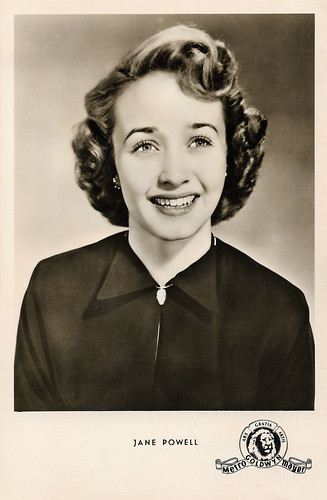
West-German postcard by Kunst und Bild, Berlin, no. A 327. Photo: Metro-Goldwyn-Mayer.
Charm and spunk
Jane Powell was born Suzanne Lorraine Burce in 1929 in Portland, Oregon. She was the only child born to Paul E. Burce and Eileen Baker Burce. Her father worked for Wonder Bread for almost 20 years, before the family moved to Oakland.
Suzanne was singing and dancing at an early age. Aged five, she appeared on the children's radio program 'Stars of Tomorrow'. She attended Agnes Peters Dancing School as a child in Portland. At 12, Powell had her career taken over by a local promoter, Carl Werner, who helped her get selected as the Oregon Victory Girl. She toured the state as the Oregon Victory Girl singing and selling victory bonds.
Her role model and favourite actress was Jeanette MacDonald. In the summer of 1943, Paul and Eileen Burce took their daughter on vacation to Hollywood. There, she appeared on Janet Gaynor 's radio show 'Hollywood Showcase: Stars over Hollywood'. The show was a talent competition. Suzanne won the competition and soon auditioned for Louis B. Mayer at MGM, as well as for David O. Selznick.
Without even taking a screen test, she was then signed to a seven-year contract with MGM. The character she played in her first film Song of the Open Road (S. Sylvan Simon, 1944) was named Jane Powell. MGM gave her the name of the character she played for her own stage moniker.
Through the 1940s and 1950s, she had a successful career in film musicals. Powell's charm and spunk made her stand out in Three Daring Daughters (Fred M. Wilcox, 1948), in which she co-starred with Jeanette MacDonald. She had her breakthrough with the musical A Date with Judy (Richard Thorpe, 1948) co-starring Wallace Beery and Elizabeth Taylor . The film was based on the radio series of the same name.
Jane replaced June Allyson and Judy Garland for the role in Royal Wedding (Stanley Donen, 1951) opposite Fred Astaire and Peter Lawford. She appeared with Vic Damone in four films: Rich, Young and Pretty (Norman Taurog, 1951) also with Danielle Darrieux, Athena (Richard Thorpe, 1954) also with Edmund Purdom and Debbie Reynolds, Deep in My Heart (Stanley Donen, 1954) with José Ferrer, and Hit the Deck (Roy Rowland, 1955), also with Tony Martin and Debbie Reynolds.
But Jane Powell is best known for her role as Milly in Seven Brides for Seven Brothers (Stanley Donen, 1954), swept off her feet by the charms of Howard Keel. Seven Brides for Seven Brothers, which is set in Oregon in 1850, is particularly known for Michael Kidd's unusual choreography, which makes dance numbers out of such mundane frontier pursuits as chopping wood and raising a barn.
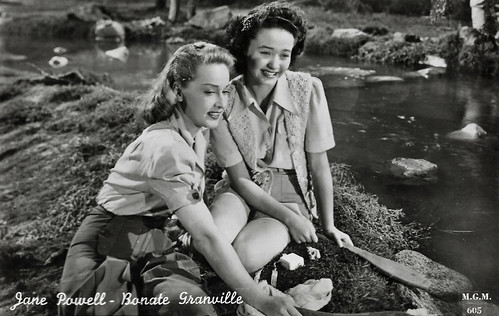
Dutch postcard, no. 605. Photo: M.G.M. Jane Powell and Bonita Granville in Song of the Open Road (S. Sylvan Simon, 1944). Sent by mail in 1954.
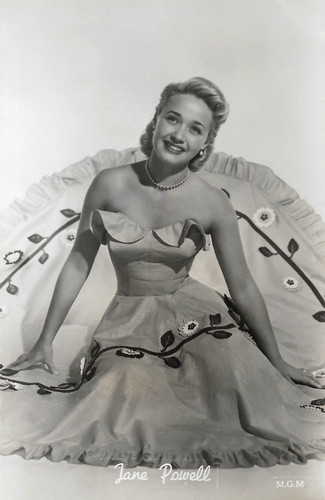
Vintage postcard. Photo: MGM.
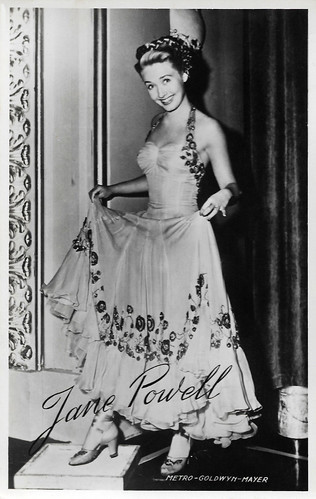
Vintage postcard. Photo: Metro-Goldwyn-Mayer.
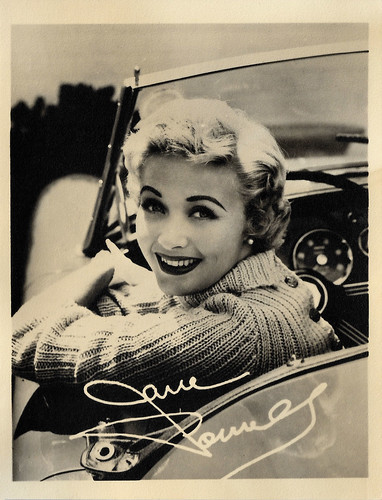
Vintage autograph card.
A move to the East Coast
However, in 1957, Jane Powell had outgrown her innocent girl-next-door image. She appeared in a rare dramatic role in The Female Animal (Harry Keller, 1958) from Universal Pictures, which turned out to be the final film of co-star Hedy Lamarr . With the decline of film musicals in the late 1950s, Jane left MGM before they could fire her.
She resuscitated her career by making a move to the East Coast and appearing on the musical stage. Since then, she made brief returns to acting in front of the camera: on television, in commercials, and in a workout video. She has had a variety of roles on stage since the end of her film career, including the musicals 'The Sound of Music', 'Oklahoma!', 'My Fair Lady', and 'Carousel'.
Her Broadway debut was in 'Irene', in which she followed Debbie Reynolds in the title role. Howard Keel and she also appeared on stage together in a revival of 'Seven Brides for Seven Brothers', 'I Do! I Do!' and 'South Pacific'. In the early 1980s, she toured in the comedies 'Same Time, Next Year'; 'The Marriage-Go-Round' and 'Chapter Two'. She also did the one-woman show 'The Girl Next Door and How She Grew', from which she took the title of her 1988 autobiography.
Jane Powell was married five times, of which the first four ended in a divorce. Her husbands were professional figure skater Geary Steffin (1949-1954) with whom she had two children; Patrick Nerney (1954-1964) with whom she had one child; James D. Fitzgerald (1965-1976), David Stellar Parlour (1978-1981), and finally former youth star and actor Dickie Moore (1988- his death in 2015). She had never met Moore until 1981 when he was researching his book on child stars, 'Twinkle, Twinkle, Little Star'.
Her children were Geary Anthony "G.A." Steffen III (1951), Suzanne Ilene "Sissy"Steffen (1952), and Lindsay Averille Nerney (1956). Jane Powell was awarded a Star on the Hollywood Walk of Fame at 6818 Hollywood Boulevard in Hollywood, California in 1960. When Dickie Moore died in 2015, Jane Powell sold their New York apartment and lived in Wilton. There she passed away on 16 September 2021. Jane Powell was 92.
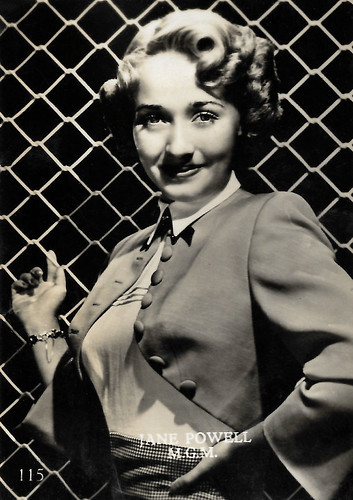
Vintage collectors card, no. 115. Photo: MGM.
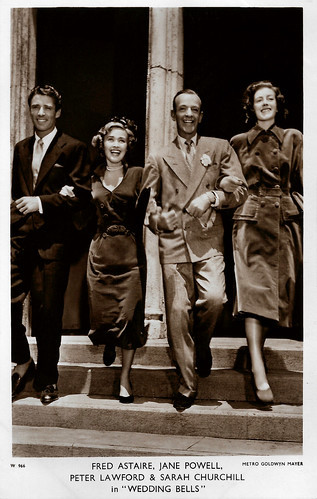
British postcard in the Picturegoer Series, London, no. W 966. Photo: Metro Goldwyn Mayer. Fred Astaire, Jane Powell, Peter Lawford, and Sarah Churchill in Royal Wedding (Stanley Donen, 1951).
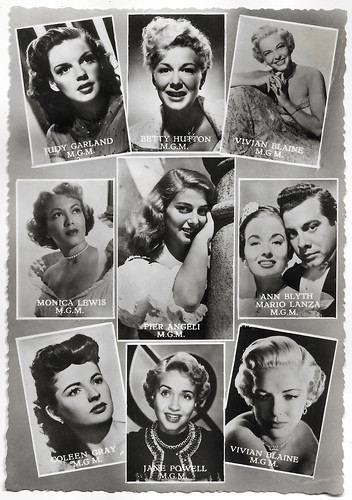
Dutch postcard by Sparo (Gebr. Spanjersberg N.V., Rotterdam). Photos: Metro-Goldwyn-Mayer. The pictured stars are Judy Garland , Betty Hutton, Vivian Blaine (twice), Monica Lewis, Pier Angeli , Ann Blyth and Mario Lanza , Coleen Gray, and Jane Powell. The postcard must date from ca. 1951, when Blyth and Lanza starred together in The Great Caruso (Richard Thorpe, 1951).
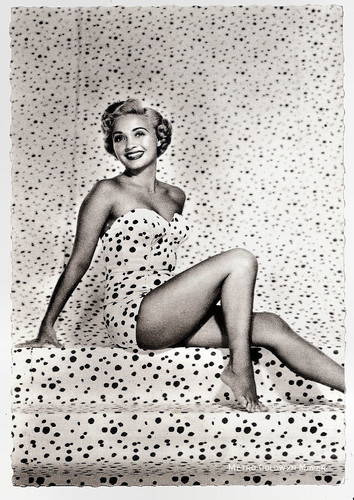
British postcard by Real Photograph / Moviestar, no. F 18. Photo: Metro-Goldwyn-Mayer.
Sources: (IMDb), Wikipedia, and .
This post was last updated on 18 September 2021.

Belgian collectors card by Kwatta, no. C. 288. Photo: MGM. Jane Powell in Nancy Goes to Rio (Robert Z. Leonard, 1950).

Dutch postcard Van Leer's Fotodrukindustrie N.V., Amsterdam, no. 251. Photo: MGM.

West-German postcard by Kunst und Bild, Berlin, no. A 327. Photo: Metro-Goldwyn-Mayer.
Charm and spunk
Jane Powell was born Suzanne Lorraine Burce in 1929 in Portland, Oregon. She was the only child born to Paul E. Burce and Eileen Baker Burce. Her father worked for Wonder Bread for almost 20 years, before the family moved to Oakland.
Suzanne was singing and dancing at an early age. Aged five, she appeared on the children's radio program 'Stars of Tomorrow'. She attended Agnes Peters Dancing School as a child in Portland. At 12, Powell had her career taken over by a local promoter, Carl Werner, who helped her get selected as the Oregon Victory Girl. She toured the state as the Oregon Victory Girl singing and selling victory bonds.
Her role model and favourite actress was Jeanette MacDonald. In the summer of 1943, Paul and Eileen Burce took their daughter on vacation to Hollywood. There, she appeared on Janet Gaynor 's radio show 'Hollywood Showcase: Stars over Hollywood'. The show was a talent competition. Suzanne won the competition and soon auditioned for Louis B. Mayer at MGM, as well as for David O. Selznick.
Without even taking a screen test, she was then signed to a seven-year contract with MGM. The character she played in her first film Song of the Open Road (S. Sylvan Simon, 1944) was named Jane Powell. MGM gave her the name of the character she played for her own stage moniker.
Through the 1940s and 1950s, she had a successful career in film musicals. Powell's charm and spunk made her stand out in Three Daring Daughters (Fred M. Wilcox, 1948), in which she co-starred with Jeanette MacDonald. She had her breakthrough with the musical A Date with Judy (Richard Thorpe, 1948) co-starring Wallace Beery and Elizabeth Taylor . The film was based on the radio series of the same name.
Jane replaced June Allyson and Judy Garland for the role in Royal Wedding (Stanley Donen, 1951) opposite Fred Astaire and Peter Lawford. She appeared with Vic Damone in four films: Rich, Young and Pretty (Norman Taurog, 1951) also with Danielle Darrieux, Athena (Richard Thorpe, 1954) also with Edmund Purdom and Debbie Reynolds, Deep in My Heart (Stanley Donen, 1954) with José Ferrer, and Hit the Deck (Roy Rowland, 1955), also with Tony Martin and Debbie Reynolds.
But Jane Powell is best known for her role as Milly in Seven Brides for Seven Brothers (Stanley Donen, 1954), swept off her feet by the charms of Howard Keel. Seven Brides for Seven Brothers, which is set in Oregon in 1850, is particularly known for Michael Kidd's unusual choreography, which makes dance numbers out of such mundane frontier pursuits as chopping wood and raising a barn.

Dutch postcard, no. 605. Photo: M.G.M. Jane Powell and Bonita Granville in Song of the Open Road (S. Sylvan Simon, 1944). Sent by mail in 1954.

Vintage postcard. Photo: MGM.

Vintage postcard. Photo: Metro-Goldwyn-Mayer.

Vintage autograph card.
A move to the East Coast
However, in 1957, Jane Powell had outgrown her innocent girl-next-door image. She appeared in a rare dramatic role in The Female Animal (Harry Keller, 1958) from Universal Pictures, which turned out to be the final film of co-star Hedy Lamarr . With the decline of film musicals in the late 1950s, Jane left MGM before they could fire her.
She resuscitated her career by making a move to the East Coast and appearing on the musical stage. Since then, she made brief returns to acting in front of the camera: on television, in commercials, and in a workout video. She has had a variety of roles on stage since the end of her film career, including the musicals 'The Sound of Music', 'Oklahoma!', 'My Fair Lady', and 'Carousel'.
Her Broadway debut was in 'Irene', in which she followed Debbie Reynolds in the title role. Howard Keel and she also appeared on stage together in a revival of 'Seven Brides for Seven Brothers', 'I Do! I Do!' and 'South Pacific'. In the early 1980s, she toured in the comedies 'Same Time, Next Year'; 'The Marriage-Go-Round' and 'Chapter Two'. She also did the one-woman show 'The Girl Next Door and How She Grew', from which she took the title of her 1988 autobiography.
Jane Powell was married five times, of which the first four ended in a divorce. Her husbands were professional figure skater Geary Steffin (1949-1954) with whom she had two children; Patrick Nerney (1954-1964) with whom she had one child; James D. Fitzgerald (1965-1976), David Stellar Parlour (1978-1981), and finally former youth star and actor Dickie Moore (1988- his death in 2015). She had never met Moore until 1981 when he was researching his book on child stars, 'Twinkle, Twinkle, Little Star'.
Her children were Geary Anthony "G.A." Steffen III (1951), Suzanne Ilene "Sissy"Steffen (1952), and Lindsay Averille Nerney (1956). Jane Powell was awarded a Star on the Hollywood Walk of Fame at 6818 Hollywood Boulevard in Hollywood, California in 1960. When Dickie Moore died in 2015, Jane Powell sold their New York apartment and lived in Wilton. There she passed away on 16 September 2021. Jane Powell was 92.

Vintage collectors card, no. 115. Photo: MGM.

British postcard in the Picturegoer Series, London, no. W 966. Photo: Metro Goldwyn Mayer. Fred Astaire, Jane Powell, Peter Lawford, and Sarah Churchill in Royal Wedding (Stanley Donen, 1951).

Dutch postcard by Sparo (Gebr. Spanjersberg N.V., Rotterdam). Photos: Metro-Goldwyn-Mayer. The pictured stars are Judy Garland , Betty Hutton, Vivian Blaine (twice), Monica Lewis, Pier Angeli , Ann Blyth and Mario Lanza , Coleen Gray, and Jane Powell. The postcard must date from ca. 1951, when Blyth and Lanza starred together in The Great Caruso (Richard Thorpe, 1951).

British postcard by Real Photograph / Moviestar, no. F 18. Photo: Metro-Goldwyn-Mayer.
Sources: (IMDb), Wikipedia, and .
This post was last updated on 18 September 2021.
Published on September 09, 2021 22:00
Jane Powell
Jane Powell (1929) was the singing and dancing star of MGM musicals of the 1940s and 1950s. She is best known for her role as Milly in Seven Brides for Seven Brothers (1954).

Belgian collectors card by Kwatta, no. C. 288. Photo: MGM. Jane Powell in Nancy Goes to Rio (Robert Z. Leonard, 1950).

Dutch postcard Van Leer's Fotodrukindustrie N.V., Amsterdam, no. 251. Photo: MGM.

West-German postcard by Kunst und Bild, Berlin, no. A 327. Photo: Metro-Goldwyn-Mayer.
Charm and spunk
Jane Powell was born Suzanne Lorraine Burce in 1929 in Portland, Oregon. She was the only child born to Paul E. Burce and Eileen Baker Burce. Her father worked for Wonder Bread for almost 20 years, before the family moved to Oakland.
Suzanne was singing and dancing at an early age. Aged five, she appeared on the children's radio program 'Stars of Tomorrow'. She attended Agnes Peters Dancing School as a child in Portland. At 12, Powell had her career taken over by a local promoter, Carl Werner, who helped her get selected as the Oregon Victory Girl. She toured the state as the Oregon Victory Girl singing and selling victory bonds.
Her role model and favourite actress was Jeanette MacDonald. In the summer of 1943, Paul and Eileen Burce took their daughter on vacation to Hollywood. There, she appeared on Janet Gaynor 's radio show 'Hollywood Showcase: Stars over Hollywood'. The show was a talent competition. Suzanne won the competition and soon auditioned for Louis B. Mayer at MGM, as well as for David O. Selznick.
Without even taking a screen test, she was then signed to a seven-year contract with MGM. The character she played in her first film Song of the Open Road (S. Sylvan Simon, 1944) was named Jane Powell. MGM gave her the name of the character she played for her own stage moniker.
Through the 1940s and 1950s, she had a successful career in film musicals. Powell's charm and spunk made her stand out in Three Daring Daughters (Fred M. Wilcox, 1948), in which she co-starred with Jeanette MacDonald. She had her breakthrough with the musical A Date with Judy (Richard Thorpe, 1948) co-starring Wallace Beery and Elizabeth Taylor . The film was based on the radio series of the same name.
Jane replaced June Allyson and Judy Garland for the role in Royal Wedding (Stanley Donen, 1951) opposite Fred Astaire and Peter Lawford. She appeared with Vic Damone in four films: Rich, Young and Pretty (Norman Taurog, 1951) also with Danielle Darrieux, Athena (Richard Thorpe, 1954) also with Edmund Purdom and Debbie Reynolds, Deep in My Heart (Stanley Donen, 1954) with José Ferrer, and Hit the Deck (Roy Rowland, 1955), also with Tony Martin and Debbie Reynolds.
But Jane Powell is best known for her role as Milly in Seven Brides for Seven Brothers (Stanley Donen, 1954), swept off her feet by the charms of Howard Keel. Seven Brides for Seven Brothers, which is set in Oregon in 1850, is particularly known for Michael Kidd's unusual choreography, which makes dance numbers out of such mundane frontier pursuits as chopping wood and raising a barn.

Dutch postcard, no. 605. Photo: M.G.M. Jane Powell and Bonita Granville in Song of the Open Road (S. Sylvan Simon, 1944). Sent by mail in 1954.

Vintage postcard. Photo: MGM.

Vintage postcard. Photo: Metro-Goldwyn-Mayer.

Vintage autograph card.
A move to the East Coast
However, in 1957, Jane Powell had outgrown her innocent girl-next-door image. She appeared in a rare dramatic role in The Female Animal (Harry Keller, 1958) from Universal Pictures, which turned out to be the final film of co-star Hedy Lamarr . With the decline of film musicals in the late 1950s, Jane left MGM before they could fire her.
She resuscitated her career by making a move to the East Coast and appearing on the musical stage. Since then, she made brief returns to acting in front of the camera: on television, in commercials, and in a workout video. She has had a variety of roles on stage since the end of her film career, including the musicals 'The Sound of Music', 'Oklahoma!', 'My Fair Lady', and 'Carousel'.
Her Broadway debut was in 'Irene', in which she followed Debbie Reynolds in the title role. Howard Keel and she also appeared on stage together in a revival of 'Seven Brides for Seven Brothers', 'I Do! I Do!' and 'South Pacific'. In the early 1980s, she toured in the comedies 'Same Time, Next Year'; 'The Marriage-Go-Round' and 'Chapter Two'. She also did the one-woman show 'The Girl Next Door and How She Grew', from which she took the title of her 1988 autobiography.
Jane Powell was married five times, of which the first four ended in a divorce. Her husbands were professional figure skater Geary Steffin (1949-1954) with whom she had two children; Patrick Nerney (1954-1964) with whom she had one child; James D. Fitzgerald (1965-1976), David Stellar Parlour (1978-1981), and finally former youth star and actor Dickie Moore (1988- his death in 2015). She had never met Moore until 1981 when he was researching his book on child stars, 'Twinkle, Twinkle, Little Star'.
Her children are Geary Anthony "G.A." Steffen III (1951), Suzanne Ilene "Sissy"Steffen (1952), and Lindsay Averille Nerney (1956). Jane Powell was awarded a Star on the Hollywood Walk of Fame at 6818 Hollywood Boulevard in Hollywood, California in 1960. When Dickie Moore died in 2015, Jane Powell sold their New York apartment and now lives permanently in Wilton.

Vintage collectors card, no. 115. Photo: MGM.

British postcard in the Picturegoer Series, London, no. W 966. Photo: Metro Goldwyn Mayer. Fred Astaire, Jane Powell, Peter Lawford, and Sarah Churchill in Royal Wedding (Stanley Donen, 1951).

Dutch postcard by Sparo (Gebr. Spanjersberg N.V., Rotterdam). Photos: Metro-Goldwyn-Mayer. The pictured stars are Judy Garland , Betty Hutton, Vivian Blaine (twice), Monica Lewis, Pier Angeli , Ann Blyth and Mario Lanza , Coleen Gray, and Jane Powell. The postcard must date from ca. 1951, when Blyth and Lanza starred together in The Great Caruso (Richard Thorpe, 1951).

British postcard by Real Photograph / Moviestar, no. F 18. Photo: Metro-Goldwyn-Mayer.
Sources: (IMDb), Wikipedia, and .

Belgian collectors card by Kwatta, no. C. 288. Photo: MGM. Jane Powell in Nancy Goes to Rio (Robert Z. Leonard, 1950).

Dutch postcard Van Leer's Fotodrukindustrie N.V., Amsterdam, no. 251. Photo: MGM.

West-German postcard by Kunst und Bild, Berlin, no. A 327. Photo: Metro-Goldwyn-Mayer.
Charm and spunk
Jane Powell was born Suzanne Lorraine Burce in 1929 in Portland, Oregon. She was the only child born to Paul E. Burce and Eileen Baker Burce. Her father worked for Wonder Bread for almost 20 years, before the family moved to Oakland.
Suzanne was singing and dancing at an early age. Aged five, she appeared on the children's radio program 'Stars of Tomorrow'. She attended Agnes Peters Dancing School as a child in Portland. At 12, Powell had her career taken over by a local promoter, Carl Werner, who helped her get selected as the Oregon Victory Girl. She toured the state as the Oregon Victory Girl singing and selling victory bonds.
Her role model and favourite actress was Jeanette MacDonald. In the summer of 1943, Paul and Eileen Burce took their daughter on vacation to Hollywood. There, she appeared on Janet Gaynor 's radio show 'Hollywood Showcase: Stars over Hollywood'. The show was a talent competition. Suzanne won the competition and soon auditioned for Louis B. Mayer at MGM, as well as for David O. Selznick.
Without even taking a screen test, she was then signed to a seven-year contract with MGM. The character she played in her first film Song of the Open Road (S. Sylvan Simon, 1944) was named Jane Powell. MGM gave her the name of the character she played for her own stage moniker.
Through the 1940s and 1950s, she had a successful career in film musicals. Powell's charm and spunk made her stand out in Three Daring Daughters (Fred M. Wilcox, 1948), in which she co-starred with Jeanette MacDonald. She had her breakthrough with the musical A Date with Judy (Richard Thorpe, 1948) co-starring Wallace Beery and Elizabeth Taylor . The film was based on the radio series of the same name.
Jane replaced June Allyson and Judy Garland for the role in Royal Wedding (Stanley Donen, 1951) opposite Fred Astaire and Peter Lawford. She appeared with Vic Damone in four films: Rich, Young and Pretty (Norman Taurog, 1951) also with Danielle Darrieux, Athena (Richard Thorpe, 1954) also with Edmund Purdom and Debbie Reynolds, Deep in My Heart (Stanley Donen, 1954) with José Ferrer, and Hit the Deck (Roy Rowland, 1955), also with Tony Martin and Debbie Reynolds.
But Jane Powell is best known for her role as Milly in Seven Brides for Seven Brothers (Stanley Donen, 1954), swept off her feet by the charms of Howard Keel. Seven Brides for Seven Brothers, which is set in Oregon in 1850, is particularly known for Michael Kidd's unusual choreography, which makes dance numbers out of such mundane frontier pursuits as chopping wood and raising a barn.

Dutch postcard, no. 605. Photo: M.G.M. Jane Powell and Bonita Granville in Song of the Open Road (S. Sylvan Simon, 1944). Sent by mail in 1954.

Vintage postcard. Photo: MGM.

Vintage postcard. Photo: Metro-Goldwyn-Mayer.

Vintage autograph card.
A move to the East Coast
However, in 1957, Jane Powell had outgrown her innocent girl-next-door image. She appeared in a rare dramatic role in The Female Animal (Harry Keller, 1958) from Universal Pictures, which turned out to be the final film of co-star Hedy Lamarr . With the decline of film musicals in the late 1950s, Jane left MGM before they could fire her.
She resuscitated her career by making a move to the East Coast and appearing on the musical stage. Since then, she made brief returns to acting in front of the camera: on television, in commercials, and in a workout video. She has had a variety of roles on stage since the end of her film career, including the musicals 'The Sound of Music', 'Oklahoma!', 'My Fair Lady', and 'Carousel'.
Her Broadway debut was in 'Irene', in which she followed Debbie Reynolds in the title role. Howard Keel and she also appeared on stage together in a revival of 'Seven Brides for Seven Brothers', 'I Do! I Do!' and 'South Pacific'. In the early 1980s, she toured in the comedies 'Same Time, Next Year'; 'The Marriage-Go-Round' and 'Chapter Two'. She also did the one-woman show 'The Girl Next Door and How She Grew', from which she took the title of her 1988 autobiography.
Jane Powell was married five times, of which the first four ended in a divorce. Her husbands were professional figure skater Geary Steffin (1949-1954) with whom she had two children; Patrick Nerney (1954-1964) with whom she had one child; James D. Fitzgerald (1965-1976), David Stellar Parlour (1978-1981), and finally former youth star and actor Dickie Moore (1988- his death in 2015). She had never met Moore until 1981 when he was researching his book on child stars, 'Twinkle, Twinkle, Little Star'.
Her children are Geary Anthony "G.A." Steffen III (1951), Suzanne Ilene "Sissy"Steffen (1952), and Lindsay Averille Nerney (1956). Jane Powell was awarded a Star on the Hollywood Walk of Fame at 6818 Hollywood Boulevard in Hollywood, California in 1960. When Dickie Moore died in 2015, Jane Powell sold their New York apartment and now lives permanently in Wilton.

Vintage collectors card, no. 115. Photo: MGM.

British postcard in the Picturegoer Series, London, no. W 966. Photo: Metro Goldwyn Mayer. Fred Astaire, Jane Powell, Peter Lawford, and Sarah Churchill in Royal Wedding (Stanley Donen, 1951).

Dutch postcard by Sparo (Gebr. Spanjersberg N.V., Rotterdam). Photos: Metro-Goldwyn-Mayer. The pictured stars are Judy Garland , Betty Hutton, Vivian Blaine (twice), Monica Lewis, Pier Angeli , Ann Blyth and Mario Lanza , Coleen Gray, and Jane Powell. The postcard must date from ca. 1951, when Blyth and Lanza starred together in The Great Caruso (Richard Thorpe, 1951).

British postcard by Real Photograph / Moviestar, no. F 18. Photo: Metro-Goldwyn-Mayer.
Sources: (IMDb), Wikipedia, and .
Published on September 09, 2021 22:00
September 8, 2021
Nino Castelnuovo (1936-2021)
On Monday 6 September 2021, handsome and athletic Italian actor Nino Castelnovo passed away. His most famous role was as Guy Foucher opposite Catherine Deneuve in the classic French music drama Les parapluies de Cherbourg/The Umbrellas of Cherbourg (1964). He was 88.
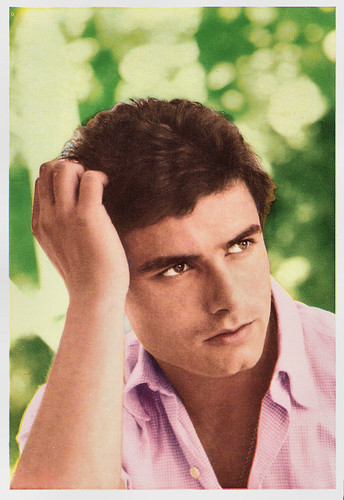
Spanish postcard by Archivo Bermejo, no. C-202, 1964. Caption: actor of the Eastmancolor film Les parapluies de Cherbourg/The Umbrellas of Cherbourg by Radio Films. Retail price: 5 Ptas.
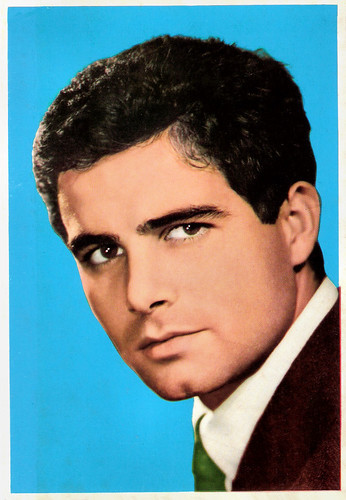
Spanish postcard by Archivo Bermejo, no. C-254, 1965. Caption: actor of the Eastmancolor film Les parapluies de Cherbourg/The Umbrellas of Cherbourg by Radio Films.
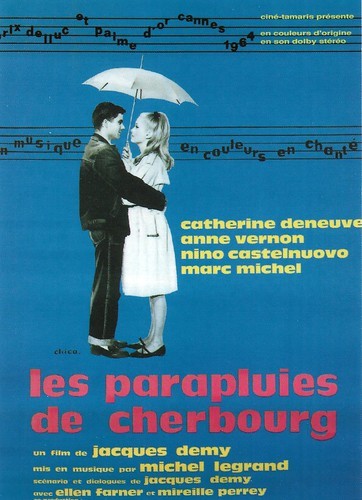
French postcard by Sonis for Cine Tamaris, Paris. Poster design by Chico. Nino Castelnuovo and Catherine Deneuve in Les parapluies de Cherbourg/The Umbrellas of Cherbourg (Jacques Demy, 1964).
The Umbrellas of Cherbourg
Francesco 'Nino' Castelnuovo was born to humble beginnings in Lecco, Lombardy, in 1936. He had two older brothers, Pierantonio and Clemente.
His working life began with a series of stints in various jobs, including house painting, as a mechanic, and as a workman. He moved to Milan where he worked as a sales agent and took drama classes at the Piccolo Teatro in Milan.
He debuted on-screen as a mime in the RAI children's television show Zurli il mago del giovedì (Zurli the wizard of Thursday). His film debut followed two years later in Un maledetto imbroglio/The Facts of Murder (Pietro Germi, 1959). He also had a small supporting part in Luchino Visconti 's classic Rocco e i suoi fratelli/Rocco and His Brothers (1960).
When the American television show Disneyland traveled to Italy in 1962, he appeared with Annette Funicello in two episodes of the mini-movie, Escapade in Florence, singing, playing the guitar, and adding the Italian verses to the jovial tarantella 'Dream Boy'.
His career gained traction with a co-starring role opposite Catherine Deneuve in the romantic musical drama Les parapluies de Cherbourg/The Umbrellas of Cherbourg (Jacques Demy, 1964) though his scenes were subsequently re-dubbed by José Bartel. Nominated for the American Academy Award for Best Foreign Language Film, the film gained the attention of both film critics and the public and won the Palme d'Or at the Cannes Film Festival in February of the same year.
Castelnuovo's greatest popularity came via the small screen, as Renzo Tramaglino, the key protagonist of the mini-series I promessi sposi/The Betrothed (Sandro Bolchi, 1967), a period piece set during the Spanish occupation of Lombardy in the 17th century and based on a best-selling novel by Alessandro Manzoni.
Other appearances have included both American and Italian-produced Westerns like The Reward (Serge Bourguignon, 1965) with Max von Sydow, and the Zapata Western Un esercito di 5 uomini/The 5-Man Army (Don Taylor, Italo Zingarelli, 1969) starring Bud Spencer . It featured a script by a young Dario Argento and a score by Ennio Morricone.
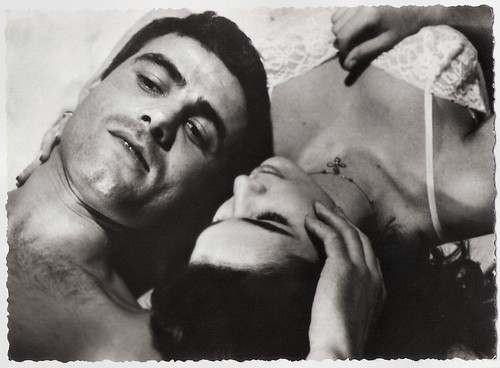
Vintage postcard. Nino Castelnuovo and Christine Delaroche in Un monde nouveau/A New World (Vittorio De Sica, 1966).
Nino Castelnuovo in a commercial for the corn-oil company Cuore. Source: Tutto Spot 80 (YouTube).
A low-budget Italian space opera produced in the wake of Star Wars
Nino Castelnuovo appeared as Armand Duval opposite Danièle Gaubert in Camille 2000 (1969), directed by Radley Metzger. The film is based on the 1848 novel and 1852 play 'La Dame aux Camélias' by Alexandre Dumas, fils. It was adapted by Michael DeForrest.
His later films included L'emmerdeur/A Pain in the Ass (Édouard Molinaro, 1973) with Jacques Brel and Lino Ventura , and the Gothic horror film Il prato macchiato di rosso/The Red-stained lawn (Riccardo Ghione, 1973),
By the early 1970s, Castelnuovo acted primarily on stage, and in serial television. From 1977 to 1982, he was seen as the athletically sound spokesman in commercials for the corn-oil company Cuore.
One of his few later film performances was a supporting part in the Science Fiction film Sette uomini d'oro nello spazio/Star Odyssey (Alfonso Brescia, 1979). It was the last of four low-budget Italian space opera films produced in the wake of Star Wars by Italian director Alfonso Brescia (under the pseudonym Al Bradley).
His final fling on the international scene was a small role as D'Agostino in The English Patient (Anthony Minghella, 1996) as an archaeologist, recalled in flashback scenes by the lead character Almásy (Ralph Fiennes).
He continued to be active on the Italian theatre stage. In 2002, he starred in a production of the 1931 comedy play 'The Front Page'. Castelnuovo retired in 2016. His last film was The Legacy Run (Massimiliano Mazza, 2016) with sports personalities Daniela Scalia, Luca Tramontin, and Marco Baron.
Nino Castelnuovo passed away after a long illness in Rome in 2021. He was 84. Castelnuovo had a son, Lorenzo, with actress Danila Trebbi. Since 2010, he was married to actress Maria Cristina Di Nicola.
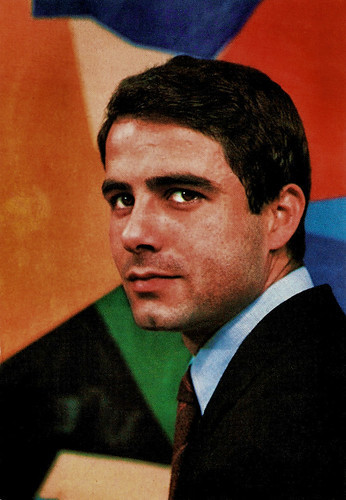
Spanish postcard by Postal Oscarcolor, no. 396.
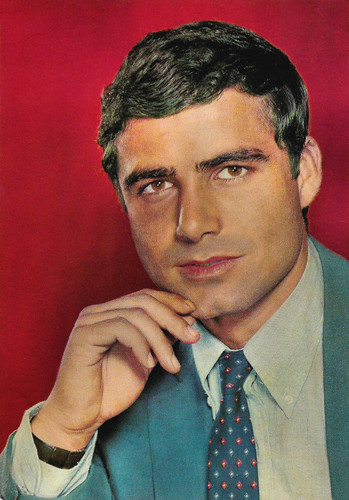
Spanish postcard by Postal Oscarcolor, no. 476. Photo: RCA Victor / 20th Century Fox.
Sources: (IMDb), Wikipedia, and .

Spanish postcard by Archivo Bermejo, no. C-202, 1964. Caption: actor of the Eastmancolor film Les parapluies de Cherbourg/The Umbrellas of Cherbourg by Radio Films. Retail price: 5 Ptas.

Spanish postcard by Archivo Bermejo, no. C-254, 1965. Caption: actor of the Eastmancolor film Les parapluies de Cherbourg/The Umbrellas of Cherbourg by Radio Films.

French postcard by Sonis for Cine Tamaris, Paris. Poster design by Chico. Nino Castelnuovo and Catherine Deneuve in Les parapluies de Cherbourg/The Umbrellas of Cherbourg (Jacques Demy, 1964).
The Umbrellas of Cherbourg
Francesco 'Nino' Castelnuovo was born to humble beginnings in Lecco, Lombardy, in 1936. He had two older brothers, Pierantonio and Clemente.
His working life began with a series of stints in various jobs, including house painting, as a mechanic, and as a workman. He moved to Milan where he worked as a sales agent and took drama classes at the Piccolo Teatro in Milan.
He debuted on-screen as a mime in the RAI children's television show Zurli il mago del giovedì (Zurli the wizard of Thursday). His film debut followed two years later in Un maledetto imbroglio/The Facts of Murder (Pietro Germi, 1959). He also had a small supporting part in Luchino Visconti 's classic Rocco e i suoi fratelli/Rocco and His Brothers (1960).
When the American television show Disneyland traveled to Italy in 1962, he appeared with Annette Funicello in two episodes of the mini-movie, Escapade in Florence, singing, playing the guitar, and adding the Italian verses to the jovial tarantella 'Dream Boy'.
His career gained traction with a co-starring role opposite Catherine Deneuve in the romantic musical drama Les parapluies de Cherbourg/The Umbrellas of Cherbourg (Jacques Demy, 1964) though his scenes were subsequently re-dubbed by José Bartel. Nominated for the American Academy Award for Best Foreign Language Film, the film gained the attention of both film critics and the public and won the Palme d'Or at the Cannes Film Festival in February of the same year.
Castelnuovo's greatest popularity came via the small screen, as Renzo Tramaglino, the key protagonist of the mini-series I promessi sposi/The Betrothed (Sandro Bolchi, 1967), a period piece set during the Spanish occupation of Lombardy in the 17th century and based on a best-selling novel by Alessandro Manzoni.
Other appearances have included both American and Italian-produced Westerns like The Reward (Serge Bourguignon, 1965) with Max von Sydow, and the Zapata Western Un esercito di 5 uomini/The 5-Man Army (Don Taylor, Italo Zingarelli, 1969) starring Bud Spencer . It featured a script by a young Dario Argento and a score by Ennio Morricone.

Vintage postcard. Nino Castelnuovo and Christine Delaroche in Un monde nouveau/A New World (Vittorio De Sica, 1966).
Nino Castelnuovo in a commercial for the corn-oil company Cuore. Source: Tutto Spot 80 (YouTube).
A low-budget Italian space opera produced in the wake of Star Wars
Nino Castelnuovo appeared as Armand Duval opposite Danièle Gaubert in Camille 2000 (1969), directed by Radley Metzger. The film is based on the 1848 novel and 1852 play 'La Dame aux Camélias' by Alexandre Dumas, fils. It was adapted by Michael DeForrest.
His later films included L'emmerdeur/A Pain in the Ass (Édouard Molinaro, 1973) with Jacques Brel and Lino Ventura , and the Gothic horror film Il prato macchiato di rosso/The Red-stained lawn (Riccardo Ghione, 1973),
By the early 1970s, Castelnuovo acted primarily on stage, and in serial television. From 1977 to 1982, he was seen as the athletically sound spokesman in commercials for the corn-oil company Cuore.
One of his few later film performances was a supporting part in the Science Fiction film Sette uomini d'oro nello spazio/Star Odyssey (Alfonso Brescia, 1979). It was the last of four low-budget Italian space opera films produced in the wake of Star Wars by Italian director Alfonso Brescia (under the pseudonym Al Bradley).
His final fling on the international scene was a small role as D'Agostino in The English Patient (Anthony Minghella, 1996) as an archaeologist, recalled in flashback scenes by the lead character Almásy (Ralph Fiennes).
He continued to be active on the Italian theatre stage. In 2002, he starred in a production of the 1931 comedy play 'The Front Page'. Castelnuovo retired in 2016. His last film was The Legacy Run (Massimiliano Mazza, 2016) with sports personalities Daniela Scalia, Luca Tramontin, and Marco Baron.
Nino Castelnuovo passed away after a long illness in Rome in 2021. He was 84. Castelnuovo had a son, Lorenzo, with actress Danila Trebbi. Since 2010, he was married to actress Maria Cristina Di Nicola.

Spanish postcard by Postal Oscarcolor, no. 396.

Spanish postcard by Postal Oscarcolor, no. 476. Photo: RCA Victor / 20th Century Fox.
Sources: (IMDb), Wikipedia, and .
Published on September 08, 2021 22:00
Paul van Yperen's Blog
- Paul van Yperen's profile
- 13 followers
Paul van Yperen isn't a Goodreads Author
(yet),
but they
do have a blog,
so here are some recent posts imported from
their feed.



